


|
Commenced:
|
01/11/2010 |
|---|---|
|
Submitted:
|
10/06/2011 |
|
Last updated:
|
07/10/2015 |
|
Location:
|
Winston Salem, North Carolina, US |
|
Website:
|
finchj9b.tumblr.com |
|
Climate zone:
|
Warm Temperate |
(projects i'm involved in)
Back to Nottinghill Edible Forest Garden
Project: Nottinghill Edible Forest Garden
Posted by Joshua Finch over 12 years ago
Caution: If you think this is PHOTO HEAVY (which it is), you should see the slide shows.
This update will take the viewer through the first half of 2012. Cover cropping is our method of building soil fertility, initiating habitat requirements for beneficial organisms, and generally being a great way to ease into permaculture concepts.
Changes in the landscape will be much less pronounced, but no less important! While it may not be as dramatic as ripping out a lawn, the ability of our landscape to react to last year's hard labor showed itself throughout the winter and into the summer.
This will be a very long update as I chose to include many more photographs than the time previous. Anyway, you can see more up to date photos and information at my little blog as well as at PRI's forum under Member Systems.
I should note that this is a reposting of another entry I posted elsewhere (not a permaculture audience, so most of this written info will be very basic). Along with that, I should also mention that- if I may say so- I think my narration was much better in these slide shows than the previous ones. But who knows- enjoy some pictures if you don't like my voice (and there is always the mute button).
January-February 6 2012
North Carolina experienced a very mild winter this past year. The abnormally warm temperatures allowed our mixed cultivation- polycultures- to continue growing and feeding the soil throughout the entirety of winter. Winter is a period of nutrient loss due to leeching. In order to minimize the loss of nutrients, we plant species which have the ability to capture and retain as many of these nutrients as possible.
A dormant system leeches many more nutrients than an active one.
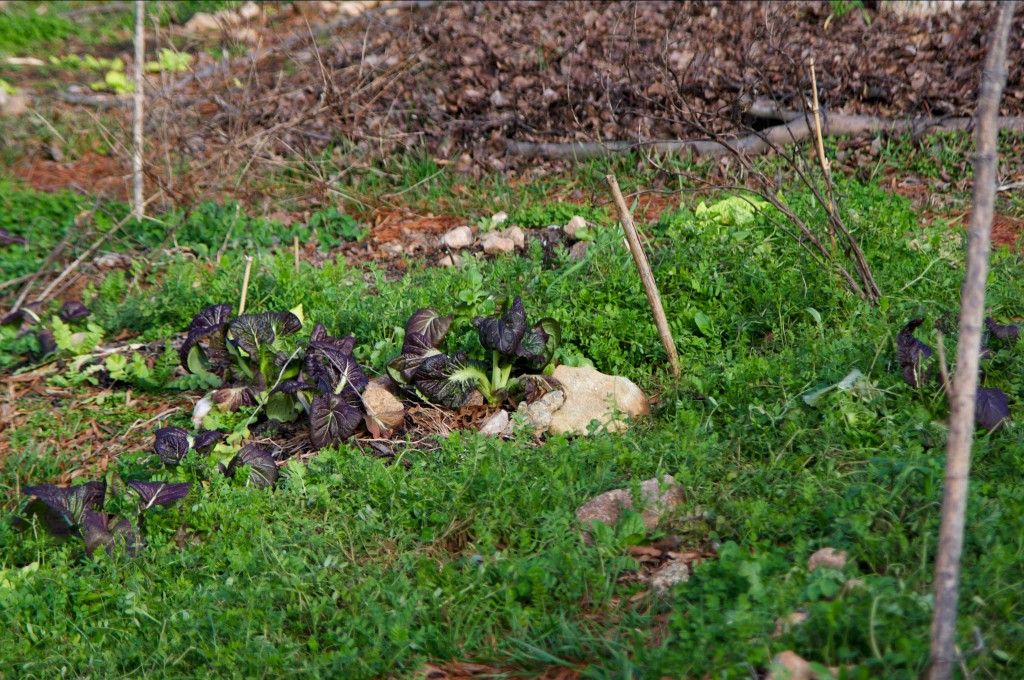
January 10, 2012. Common vetch, mustard, arugula, daikon radish, two kinds of spinach, cabbages, and other plants continue to grow throughout the winter.
If we had allowed our garden to go dormant during the winter, we wouldn't be responsibly stewarding it. Our lack of effort would also put us in for a special treat: undesirable species whose seeds have drifted into our garden over the past year would be given sunlight and water- two of the major factors in germination. By choosing the species we wish to grow, we prohibit sunlight from reaching the soil, reducing the numbers of undesirables. And with a "winter" like we had, we would have been facing an uphill battle.
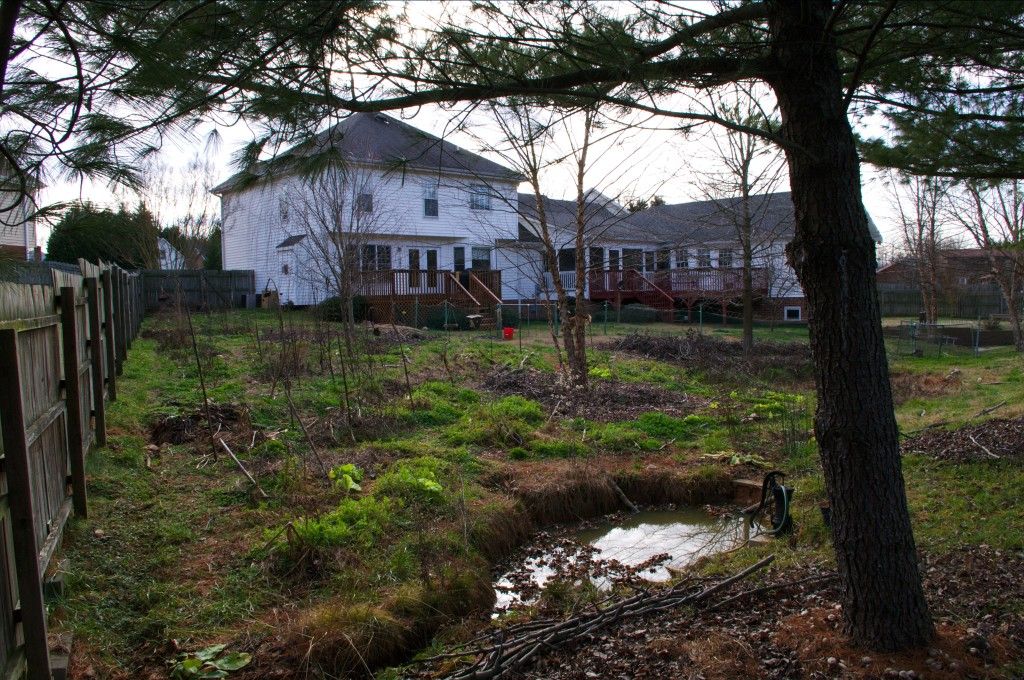
January 25, 2012. Looking from my favorite vantage point, most of the garden is visible to some extent. As the cover cropping of the next few years continues, we will be adding a shrub layer to the garden. This will help quite a bit in adding structural diversity to the garden. The trees are already large enough to be home to birds in spring, but we want to add some thicket like areas either inside the fence our in our "zone4/5" as over wintering for birds.
Instead, our chosen plants have the ability to rapidly respond to changing weather patterns for early growth, rather than undesirables. A mild winter in our climate is also a good time to do some of the heavier earth works- which are not too fun in the summer!
These raised beds were built with subsoil (clay) from the pond excavations and offer a good growing site during the winter due to their large southern faces as well as their canopy of pine trees which prevents a very little bit of heat loss. Even a degree or two can make the difference between growth and a shut down.

February 6, 2012. I finally have the time and inclination to move the giant mound of clay left from my brother's pond digging last summer. The mounds could have used a lot more wood to make them true hugel beds, but we didn't have any more wood I wanted to spare. I only had enough spare mulch to do the southern faces a little bit.
February 16-March 6 2012
Winter ends very early and the pace of growth quickens. Each section of the garden had a different legume for fixing nitrogen: the southern portion of the garden is dominated by white clover; the middle (old night shade guild), red clover and alfalfa; and the bottom (old four sisters), common vetch with some others mixed in. Throughout the garden we had planted winter/cool season crops of cabbages, mustard, arugula, lettuce, garlic, onions, broccoli, kale, and many others.
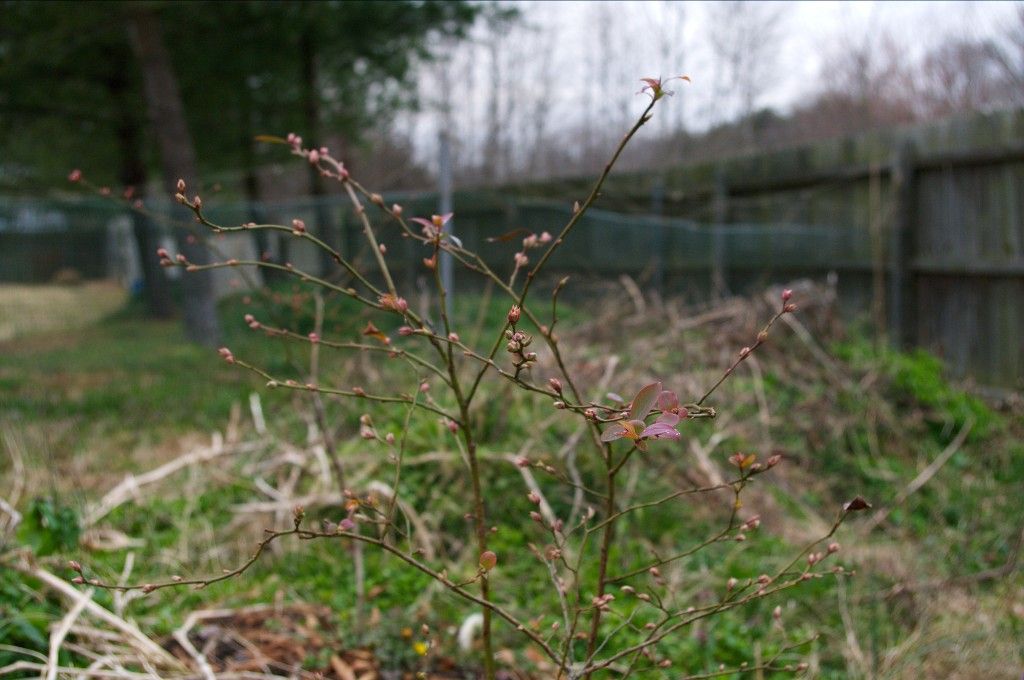
February 16, 2012. Blueberries are already leafing out. Second year after being transplanted into a mini-hugel mound.
In the following photo, I had to fix a swale I had dug with an overflow channel. The channel was a bad idea- it caused erosion and kept the swale from accumulating a maximum amount of water. Here, it has been fixed.
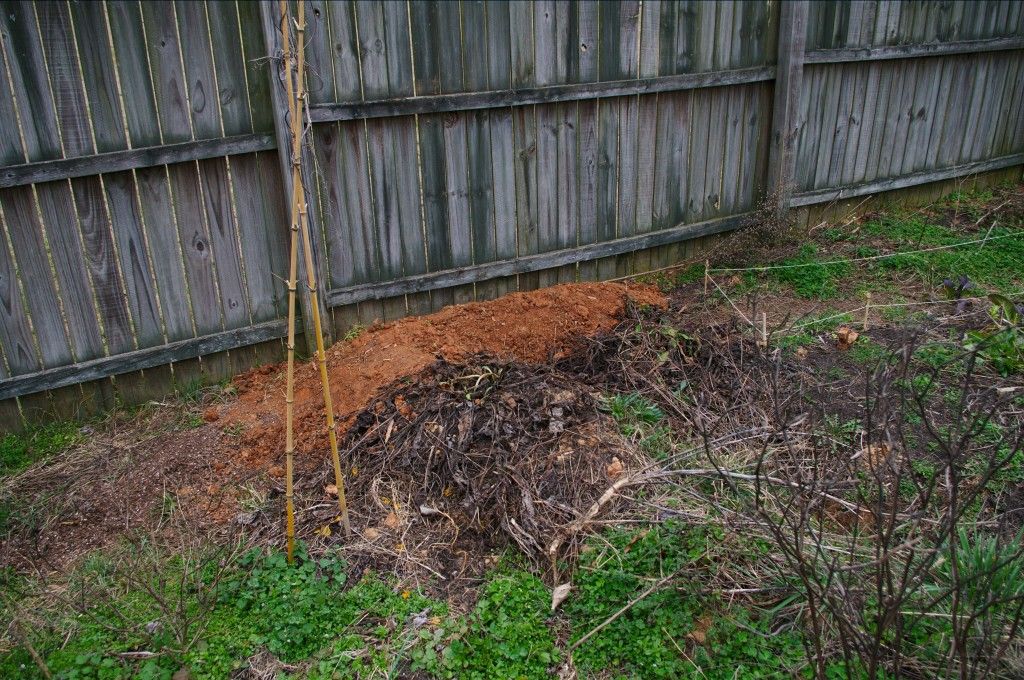
February 16, 2012. Finally decided to block off the overflow channels for both swales with elbows of soil (hah, soil... its clay). Now the water will exit out the opposite end and disperse through vegetation rather than running down and causing a gully.
A warm winter means very early flowers from some of our crops. I honestly don't think its a normal thing for plants to be flowering in February here, but it is a sign of things to come
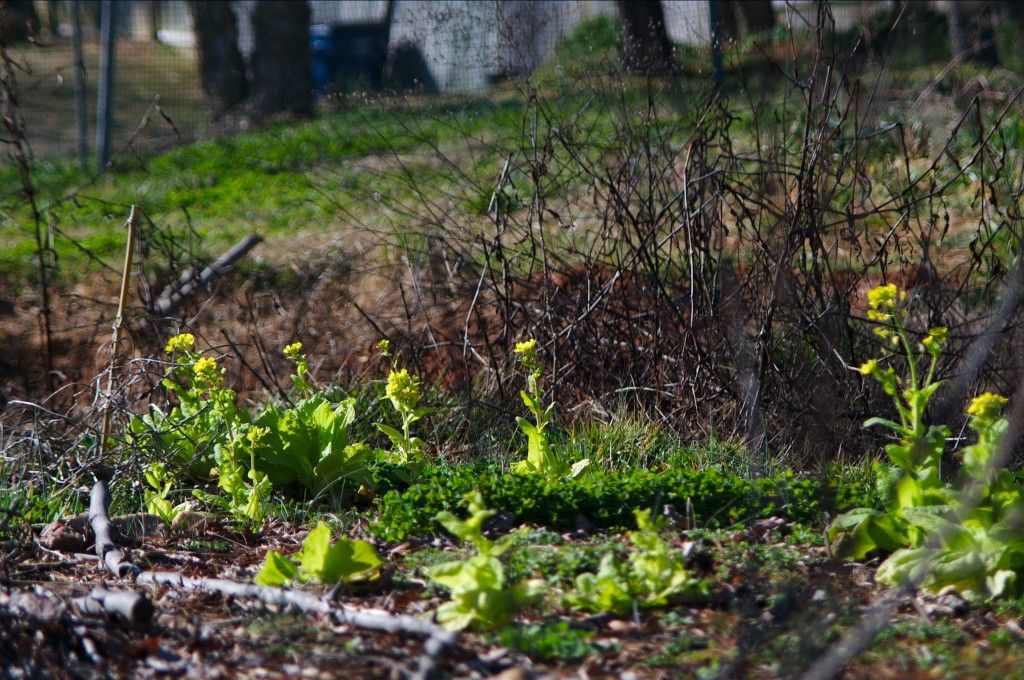
February 17, 2012. Cabbages beginning to flower in February- I think this was a combination of temperature and maturity. Either way, pretty surprising to see when everyone else's landscape is quite dormant. We did have quite a few bugs moving around, so good to offer them more energy sources besides the usual chickweed/henbit/dead nettles.
The dead vegetation in the back ground is essential overwintering habitat for insects- both beneficial and damaging. A sanitized garden is not a sound garden- everything in its place for humanity's ideas of beauty almost always mean an upset of the natural cycle. Without providing overwintering sites for beneficials, they will be slow to arrive in the garden while we need them to be permanent residents.
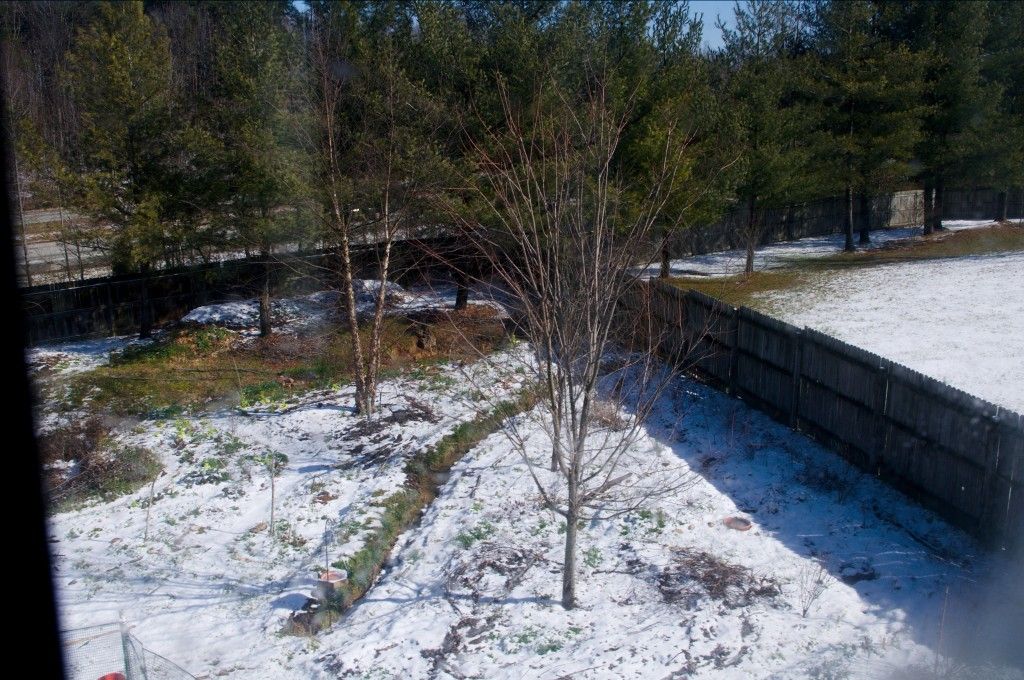
February 20, 2012. Then it snowed! Just a light dusting, but you can see how the southern facing berms and anything near standing water is too warm for the snow to remain. This is about 10am.
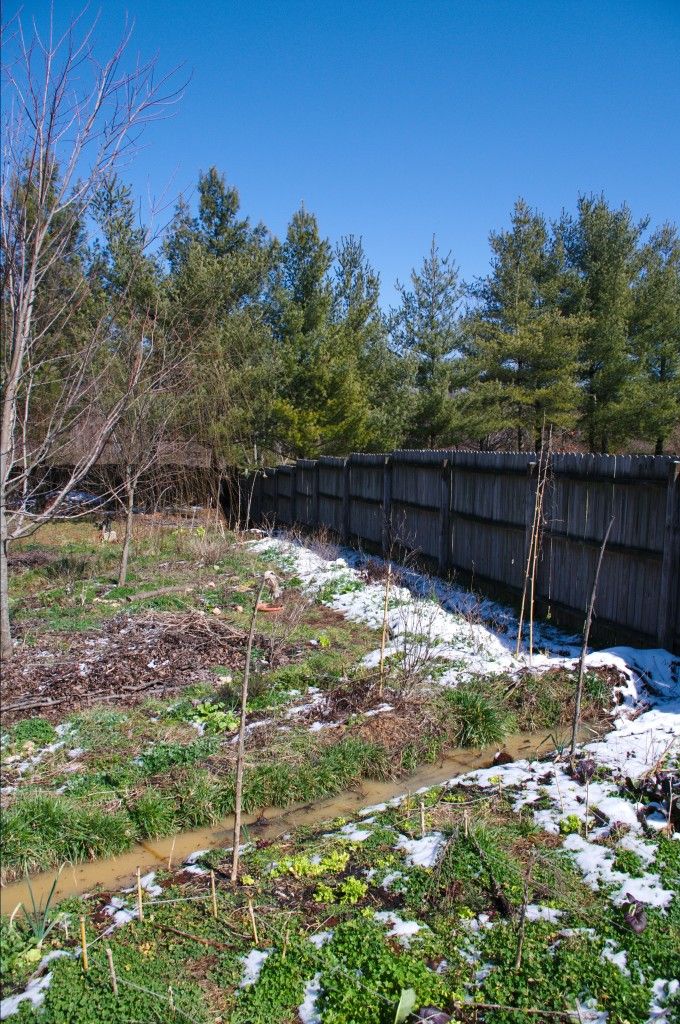
February 20, 2012. By noon the snow has melted- except the heavy shaded areas caused by the fence and house.

March 1, 2012. The same blueberry less than a month later in the early stages of flowering, there is another blueberry bush next to it beginning to leaf out (red, behind).
Watching our system emerge from winter is quite exciting. Many of the species we have chosen will live in our garden for at least three years of cover cropping and to see them grow with such vigor was a real blessing.
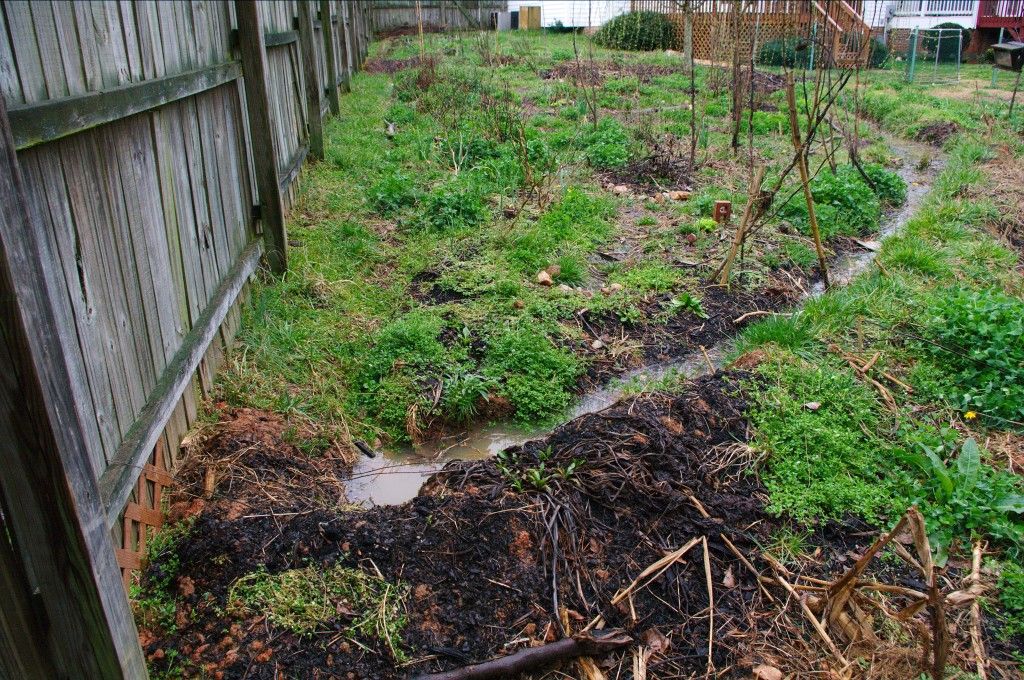
March 2, 2012. The second swale very full- nearing a bursting point since it has no way to overflow as of yet. I took this just before putting in a 'monk' to take excess water down to the upper pond to prevent a blowout. Now the second swale will finally fill across its entire length (remember due to a type one error it was off contour) and have a safety valve.
By the beginning of March, a clumpy texture begins to take form. This is the second swale, full once again. As biomass accumulates and organic matter in the soil increases, the ability of our garden to store this water for later in the year will accelerate- meaning less ups and downs in the future.
March 11-28 2012
In the larger scheme of things, cover cropping increases the resiliency of our garden. By investing in a carbon bank up front, we create the conditions in which more productive and demanding plants can flourish. Including as many sources as nectar, for as long as possible, along with habitat, we are inviting beneficial organisms to the garden to begin balancing out the herbivores. Doing this up front, rather than after we invest in costly productive fruit trees and other species is essential, in my opinion, towards guiding the system through early succession to the later stages when fruits are appropriate.
Sticking fruit trees in a lawn with some mulch around them is a recipe for disappointment. Bring in your allies before making the final push towards productivity. Of course, your mileage may vary. But I've already seen plenty of cries for "help" on permaculture forums from folks planting out trees without having prepped the soil first. Either its a lack of water or too many pests, the result is a disappointment. Therefore, perhaps care for the earth should come before our desire for food in cases of poor soils and broken habitats?
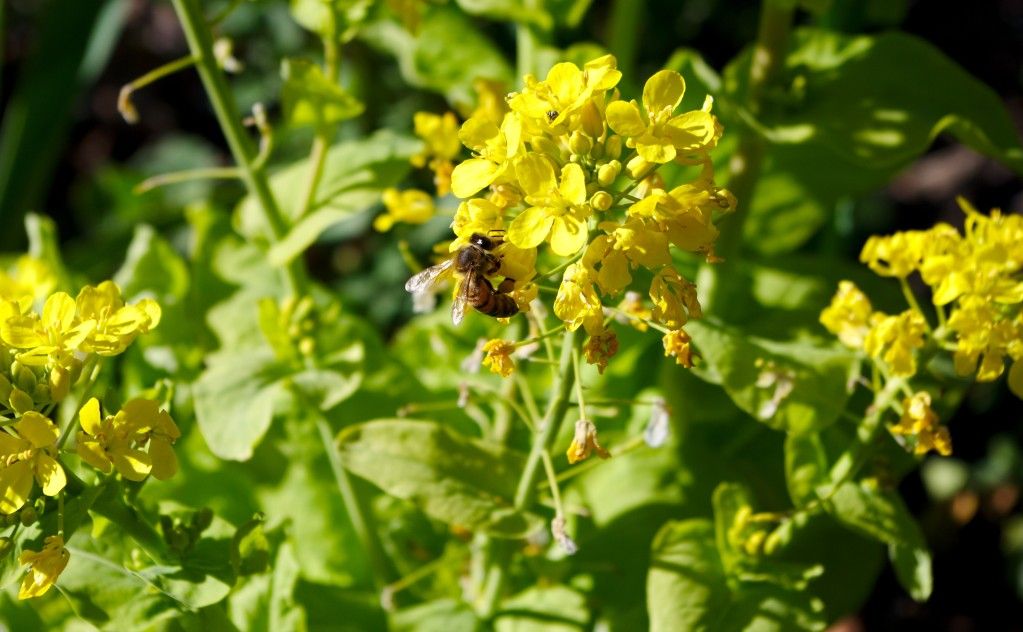
March 11, 2012. The first honey bees are spotted and if you look closely at the same flower head, you can see another insect burying its face in some nectar. :)
Resiliency is important. Fluctuating temperatures, changing climates, unpredictability- all of these demand human response. Part of that response is making sure that as insects awaken from their winter dormancy early that they aren't greeted by a dormant landscape. Instead, we have to ally ourselves with as many appropriate species as possible to help them help us!
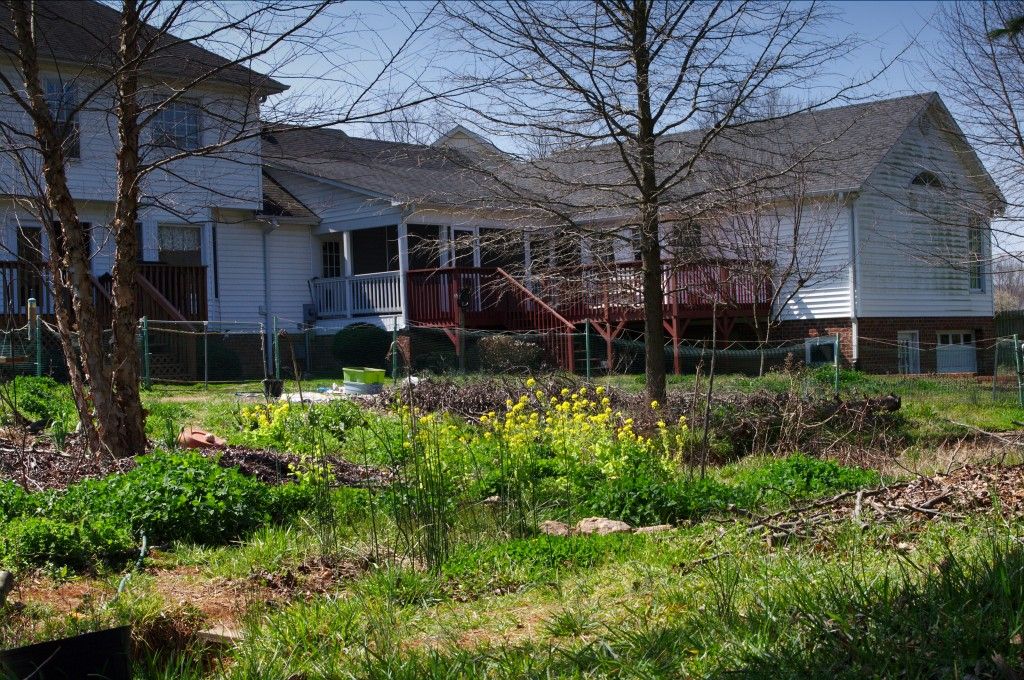
March 13, 2012. These cabbages received little to no full shade in the winter, so they were the first to begin flower. But by the end of March, most of the garden has a fair bit of nectar available.
If you were an insect, would you like to start off the new year with abundant, pesticide free pollen and nectar? And as you are a human, would you rather these early emerging insects to pollinate desirable species or "weeds"?
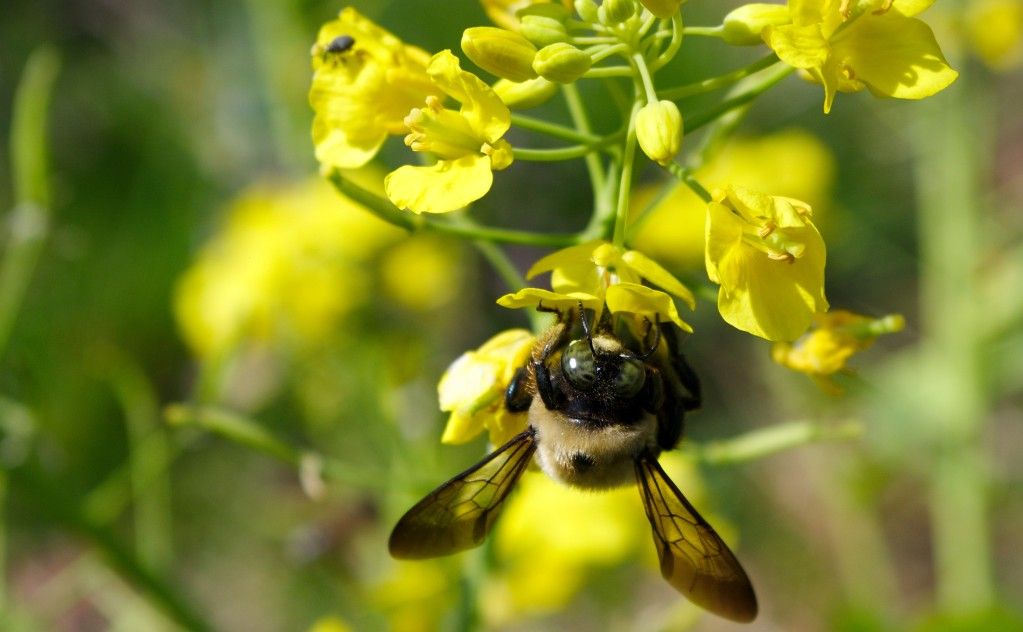
March 13, 2012. First bumble bees arrive as well. Same as the other bee photo, you can see what looks like a weevil soaking up the sun. So the insect community is appreciating our choice of plants.
As the captions say- there is more going on here than meets the eye. Everything is starting early this year and we have to make sure we manage our landscapes to meet these changes. And here is the kicker: all of this would happen without your interference anyway. Why make things harder on ourselves and work against these natural processes when we can harness their power for dramatic changes in a short period of time?
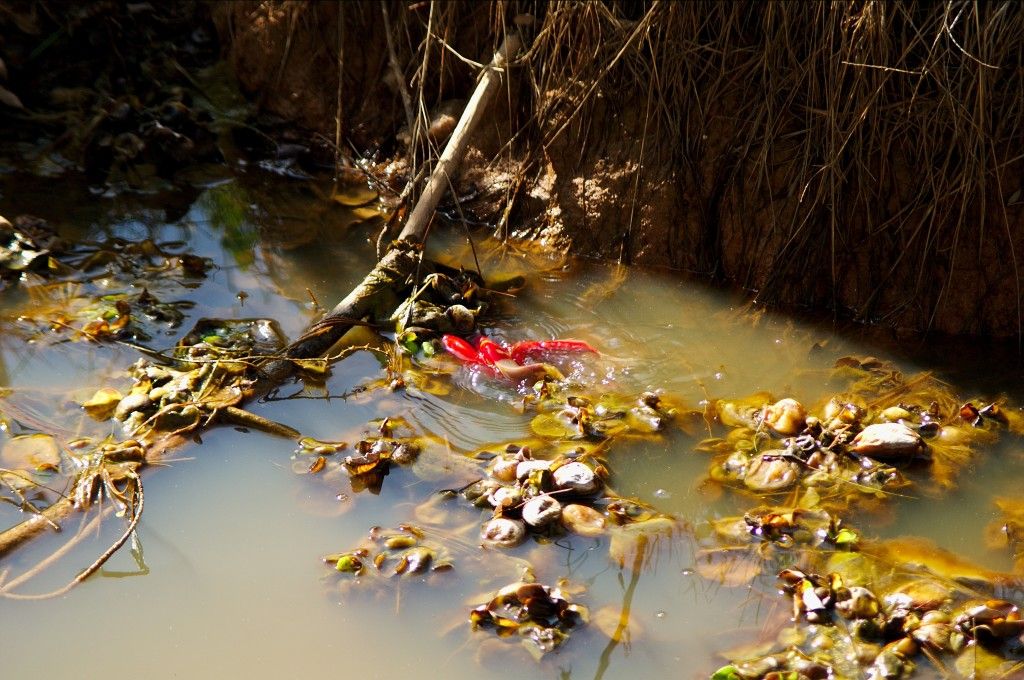
Sometime March 13-20. Love is in the... air? I had to eventually net out the females out of fear that the overzealous males would chase them to exhaustion. I put the females into the other pond with some younger fish.
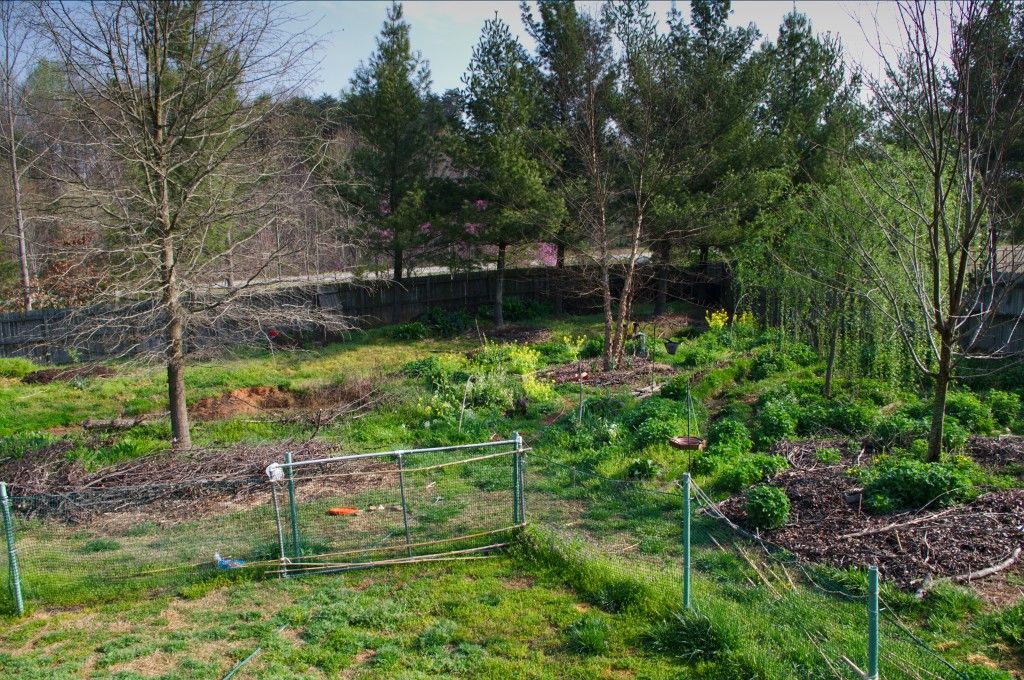
Sometime March 13-20. The legumes and everything else are almost doubling in size from the end of February, while grasses are still dormant. Satisfying results from our first cover crop.
The whole landscape- which has been charging up its batteries all through the winter begins explosive growth mid March!
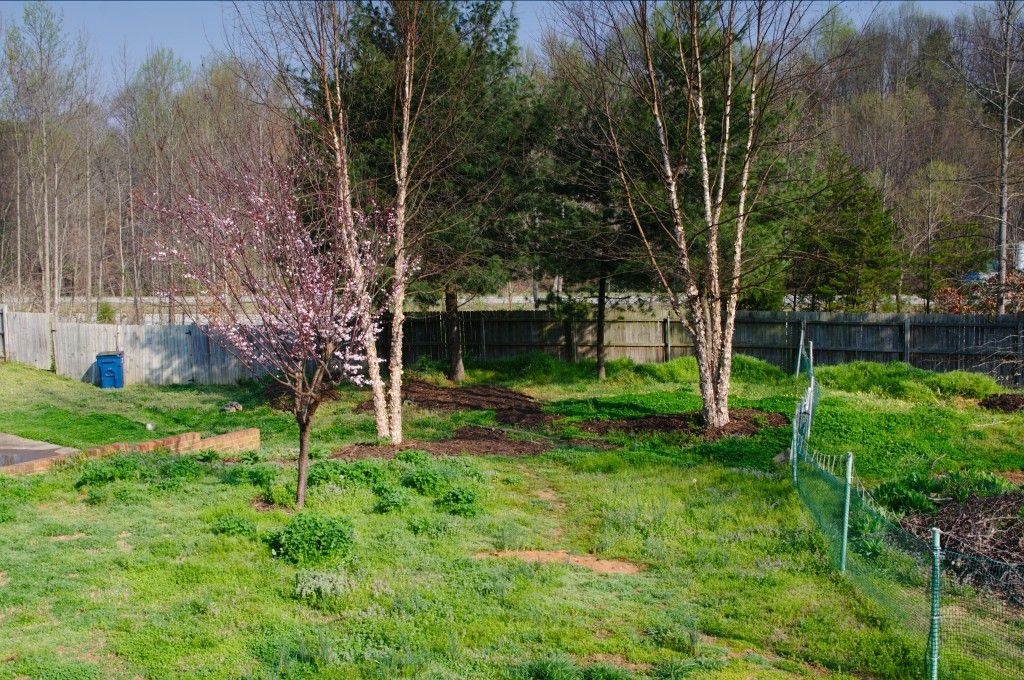
Sometime March 13-20. I could check the actual dates but too lazy. Anyway, even outside the temporary dog fence we have growth in unamended soils. Under the ornamental plum, crimson clover is returning from seeds dropped last spring.
Even outside "the garden" we can work with nature. Here, outside the fencing which keeps the dogs from swimming, some crimson clover- self sown from a paltry showing the year prior- grows under the plum. We are taking a slower route towards removing grass here. Also note the patches of mulch under the birches. These were locations where we experienced severe scalping from the lawn mower, so the mulch is acting as a bandage. We also layered the mulch thick- 4-6" so that as we walked to the basement we would avoid compacting the soil as much.

Sometime March 13-20. So warm that the comfrey is full size already, a full month before the last frost date. I shied away from cutting them until May just to play it safe. These plants had been trying to grow all winter but kept getting frost bite, but obviously we haven't had cold enough temperatures in a while.
Our last frost date is supposed to be May 1st and we already have Russian comfrey fully grown. Russian comfrey is an excellent mulch producer, source of nectar, over wintering site, and generally a great plant.
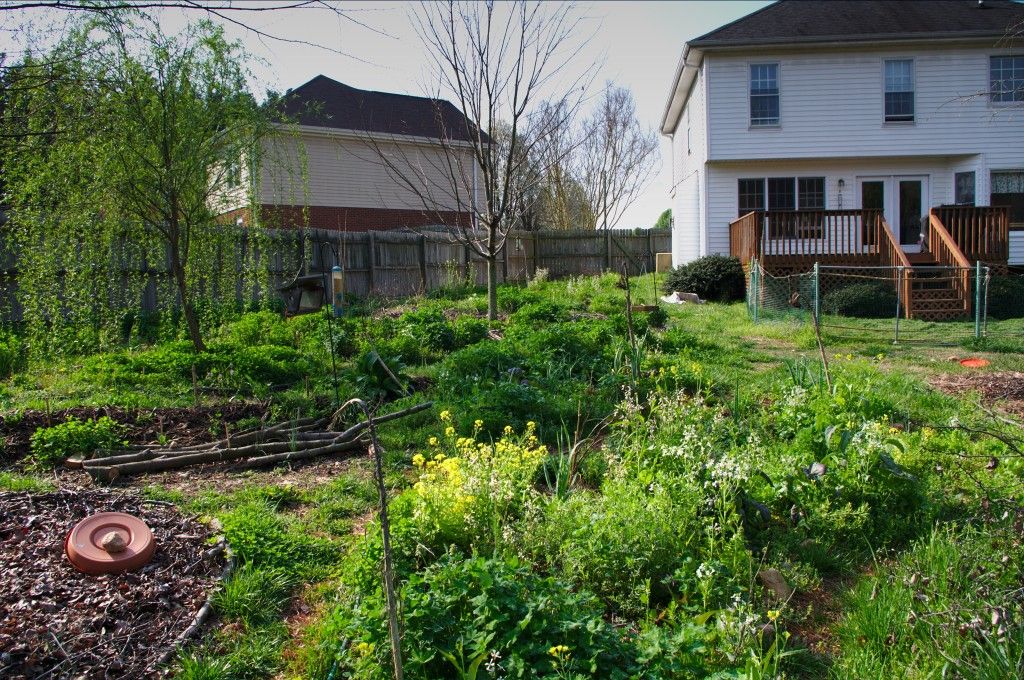
March 13-20. I'm really not sure why other people don't plant a cover crop in the winter. We were kind of speechless as the plants did what they did...
Everyone's tastes differ slightly. Your garden will not and should not look just like this. However, I will not stand for folks saying that a lawn is more beautiful than a diverse ecosystem flushing out with color in early spring. All designed for increased fertility and productivity. Even with a canopy of non-edible species, there are plenty of shade loving species which can provide us with enjoyment and food.

March 13-20. Probably the 20th. Anyway, the blueberry is now in full flower and the few bumble bees we have made sure to pollinate each and every one of these blooms.
It doesn't take long for plant with proper niche requirements met to show its appreciation. In its second year in our garden, this small blueberry bush is resplendent with flowers.
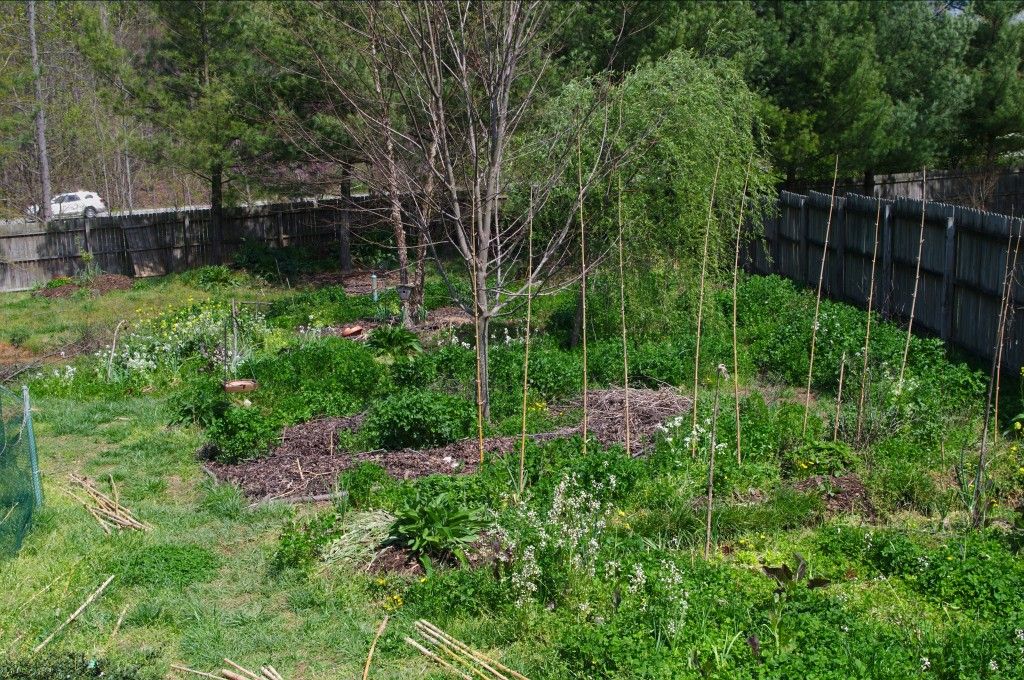
March 28, 2012. I know I haven't put any pictures of the willow from last year, that are clear anyway (if you look at July's pics [see this link], you can spot it), but take my word- its never filled out like that before. Ever. But these techniques don't work, do they?
Ah, a field of clover, alfalfa, vetch, brassicas... perennial herbs, garlic, and trees on their way to a healthy life. Hard work up front pays off.
April 2012
As the video description on YouTube says, April was tough. Not because of any traditional reason, but because surrounded by such lush growth we were always tempted to plant out much earlier than the last frost date of May 1st. We mostly played it safe and just enjoyed the show.
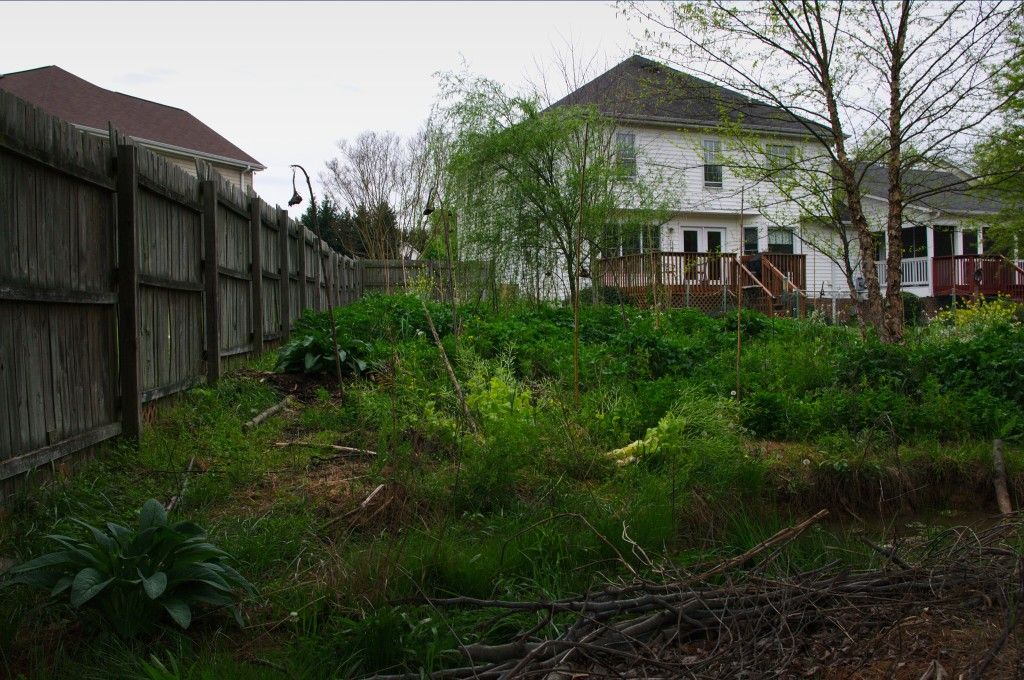
April 1, 2012. Looking south into the garden. Cabbages are on their way out, but the rest of the ground covers are coming along. First leaves on the birches emerge- after the willow and willow oak.
With the threat of frost ever decreasing, our garden grows in strides. While it may not appear that much is changing with each photograph, remember that every single day every plant is exchanging gases from the atmosphere, distributing water among its roots and the rhizosphere (root zone), as well as communicating with soil life through root excretions. The abundant growth above ground is being mimicked below ground at an even more frenzied pace.
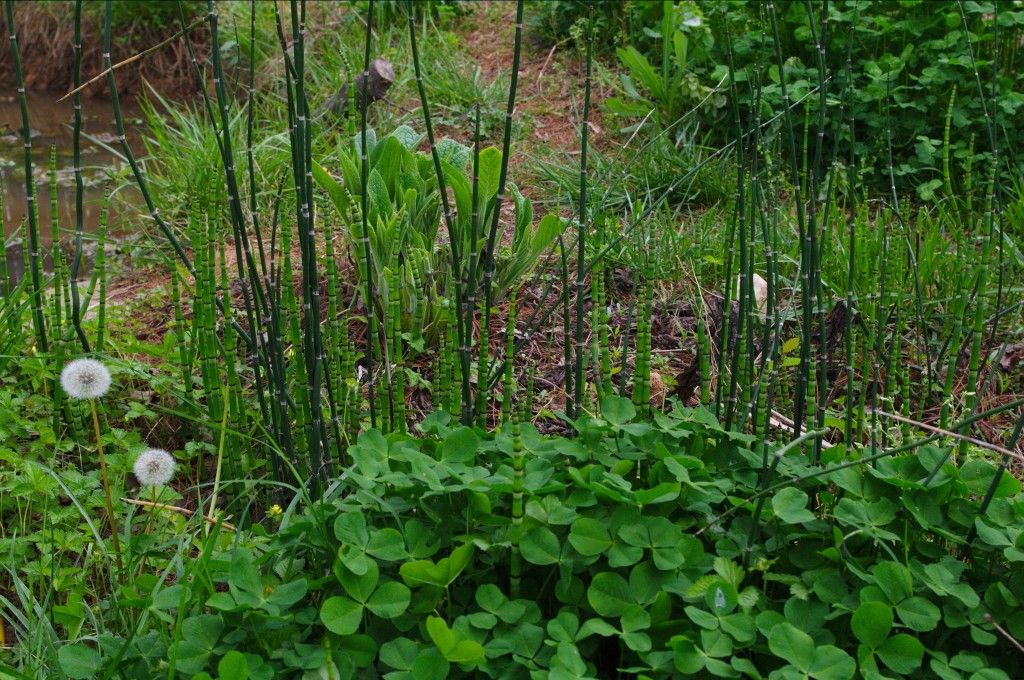
April 1, 2012. Horsetails emerging in great numbers. This is their first full year in their correct niche. Combined with nitrogen fixing white clover and a fellow dynamic accumulator of comfrey, they will expand in the "bog" area between the two ponds to act as a super nutrient sponge.
Of course, nutrients can also be lost during the growing season. So to minimize this, we plant accumulating plants to impede the flow of water soluble nutrients. Nutrient nets are an important step in minimizing energy and nutrient loss.

April 2, 2012. Looking north into the main area of the garden. Our red maple has yet to leaf out, but the red clover and alfalfa aren't waiting. Already over a foot high, it only takes a couple of weeks for these cover crops to grow to an appreciative size.
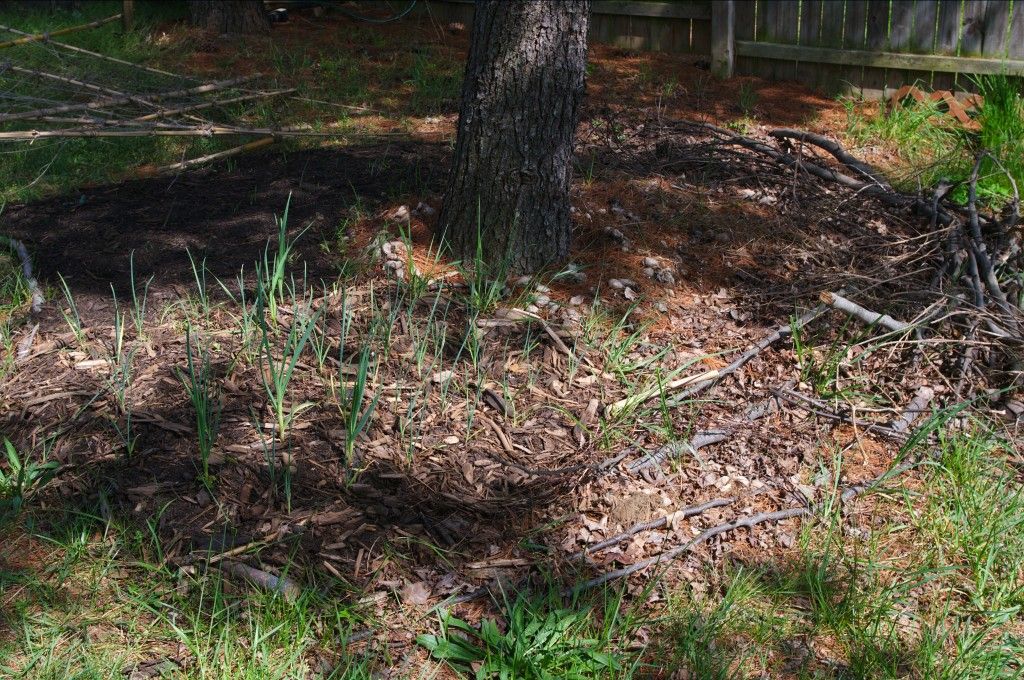
April 2, 2012. As the sun's trajectory moves overhead, our little beds under the pines on the berm begin to lose light. Since the garlic was planted in late winter rather than in the fall, they never had the time to grow very large. But they will go dormant in a month or two and re emerge in the fall- then they'll grow to a harvest size.

April 2, 2012. The white clover in the old green guild forms a very thick carpet early on, making it an ideal candidate for chop and drop.
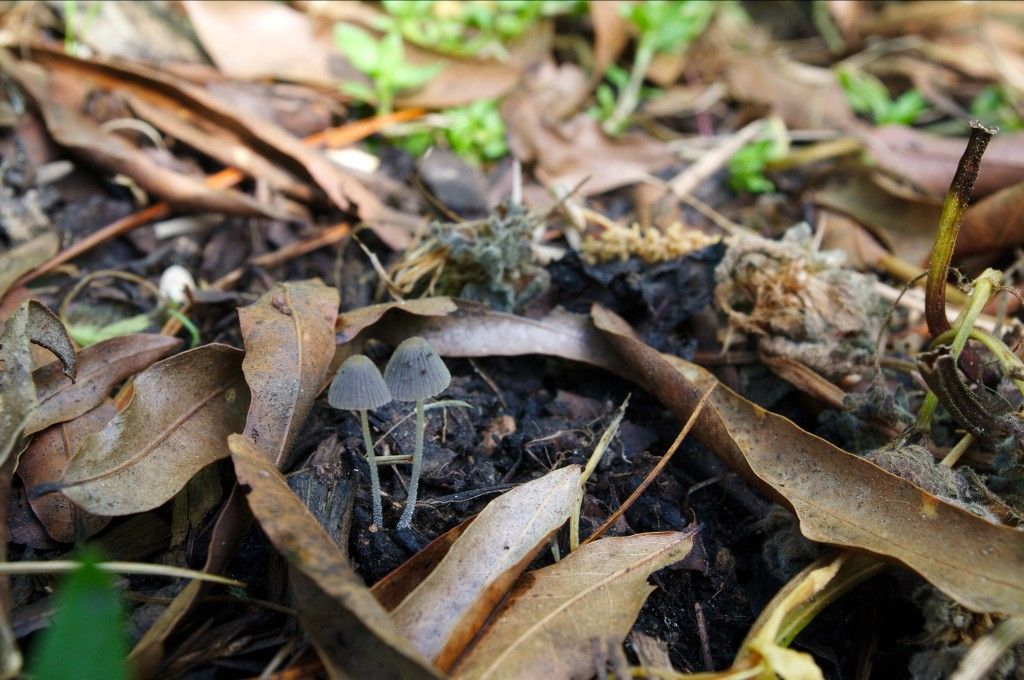
April 3, 2012. Fungi begin to reproduce as well in the warmer temperatures. We expect to begin seeing more varieties of fungi since we have begun to inoculate with ectomycorrhizal fungi in addition to endomycorrhizal species. Remember what our soils looked like and you'll know why we needed to bring them in at this early stage.

April 8, 2012. Mixed cultivation of mustard, arugula, radishes, common vetch, crimson clover, Russian comfrey, garlic, spinach, and chickweed (among others).
Maintaining the garden in this stage is relatively easy- so we could concentrate on expanding the garden and decreasing the grass. The following photo is part of the southern facing berm we sheet mulched to include in the garden. This will be one of the most productive sites due to its aspect and proximity to a pond.
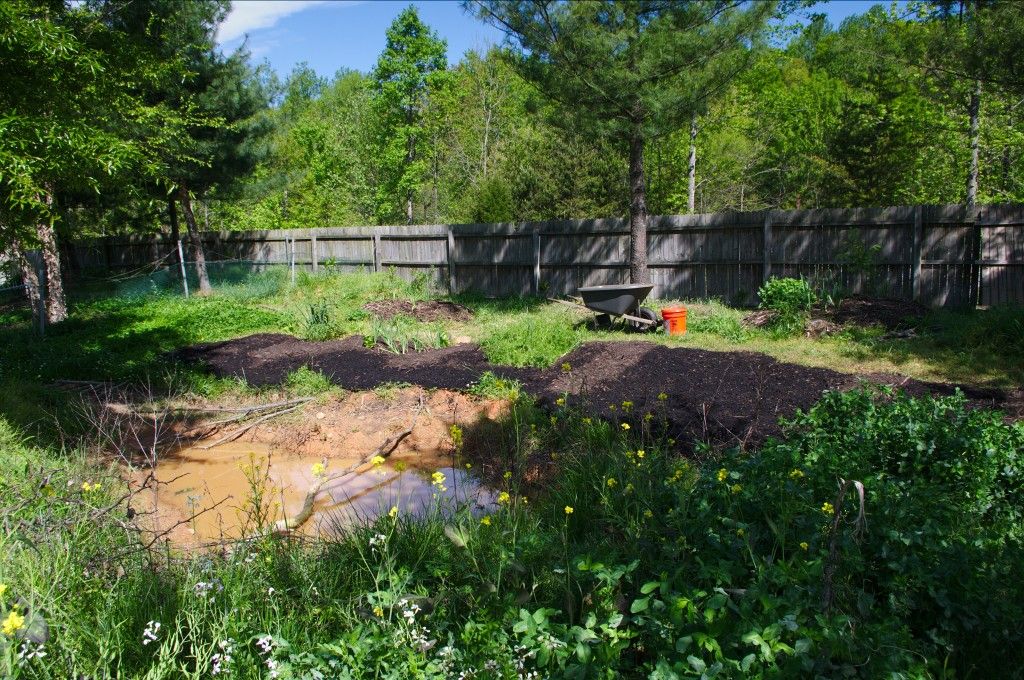
April 8, 2012. Sheet mulching completed on the south facing berm! This will be our main focus sa the rest of the garden is being stewarded by the cover crop. We can focus our efforts on expanding the garden.
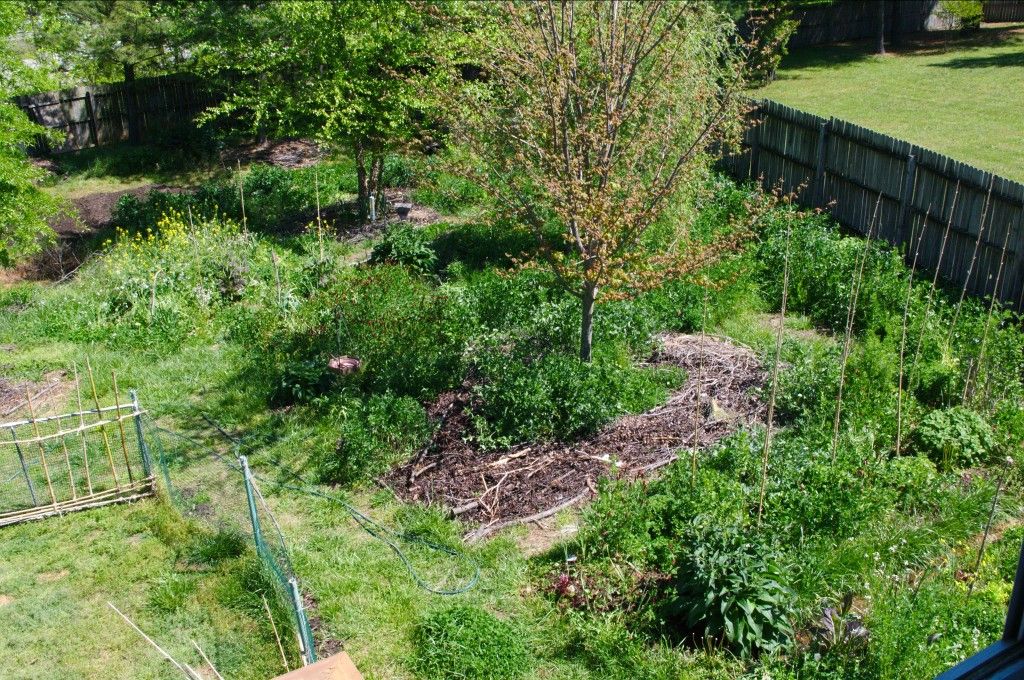
April 12, 2012. View from upstairs windows. The red maple is finally leafing out.
 April 12, 2012. Same, but looking further to the west.
April 12, 2012. Same, but looking further to the west.
The next few images show just how healthy our trees have become in just a year of applying permaculture.
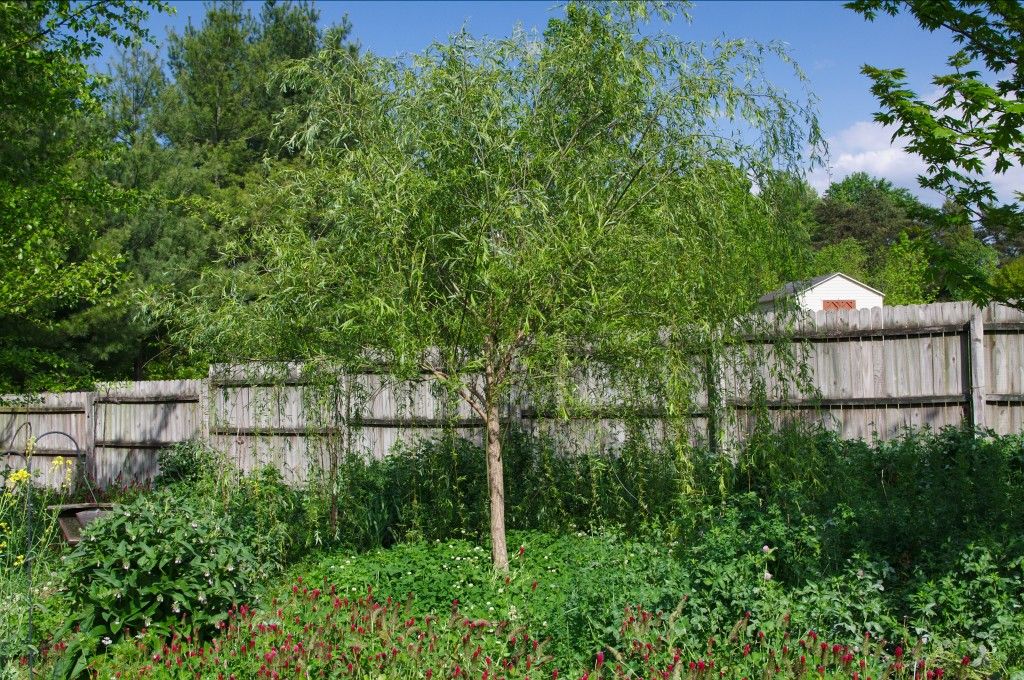
April 17, 2012. The willow, surrounded by support species, has recovered to a healthy state in just one year. We have to prune some this fall to make accessing the beds it "weeps" over easier- as well as remove some water sprouts- but all in all we are happy with its recovery.

April 17, 2012. The red maple looking rather healthy as well. Not quite as full as the others, yet, but a long way from last year when it was stricken by disease on the trunk. With access to a mulch layer and organic fertilizer (along with healthy organisms), it'll live a longer healthier life.
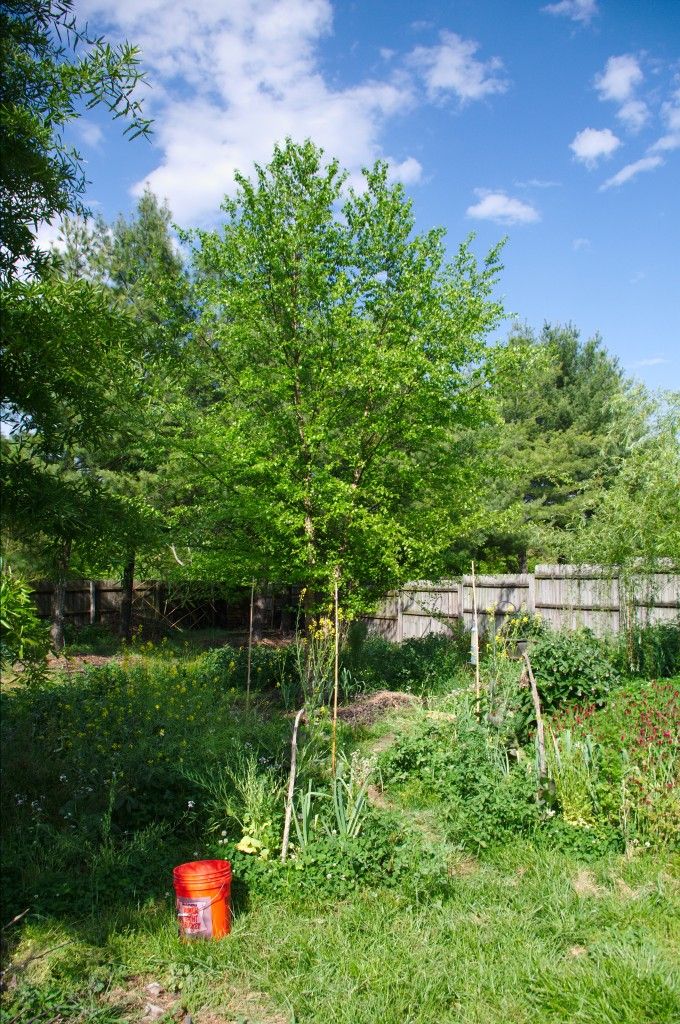
April 17, 2012. One of the river birches. These were always healthy trees, but will be happier now with access to carbon and the ability to grow feeder roots in the absence of grass competition.

April 17, 2012. Crimson clover playing host to new spider species (that we notice). The diversity of life seemed to increase by the week as more nectar and niches were available.
Did I mention how awesome it is to have frogs on patrol in your garden?
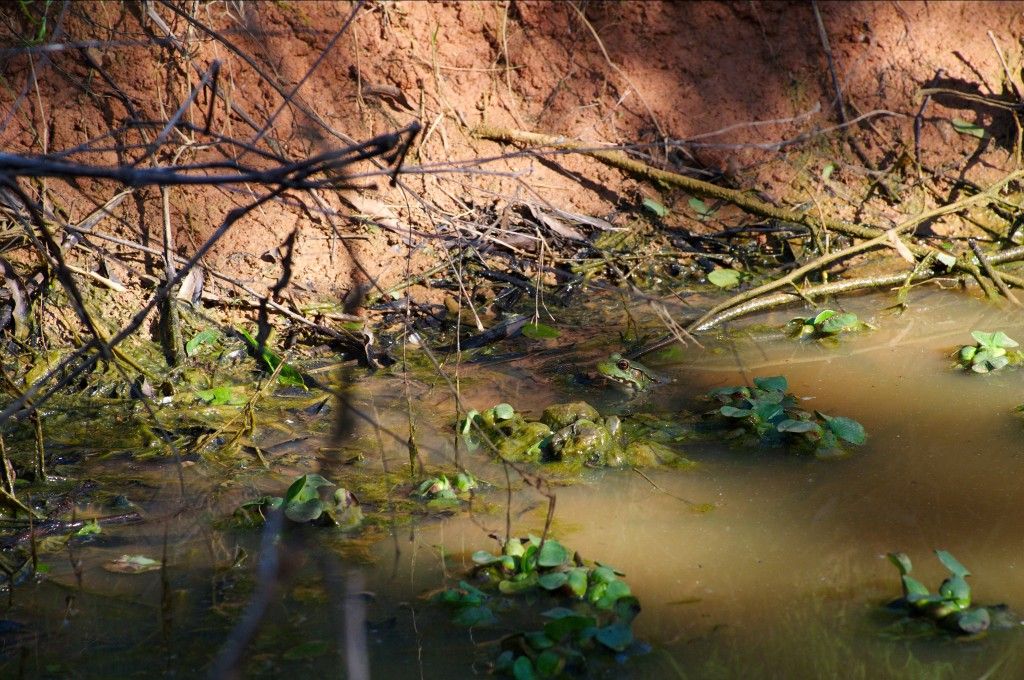
April 17, 2012. Having bested the competition, this frog remains queen of the larger pond!

April 17, 2012. A comparison photo of our neighbor's property. Her slope has a wonderful aspect and if only one day she could begin to manage it in an ecological way- not necessarily even a food forest- our property would benefit as well.
May 2012
Finally the last frost date has come and gone without incident. Now is time to plant out more species, start some extras, and begin chop and drop. Chop and drop is a nonfancy term for cutting a plant and leaving it on the ground as mulch and slow fertilizer. Many plants lend themselves well to this technique- such as nitrogen fixers and certain plants such as comfrey and horse tails. Rapid regrowth is a sign of a strong root system and an ability to procure resources.
May was split in two slide shows.
When a plant is cut, it sheds roots to maintain its unique root to shoot ratio. Therefore, we can increase the amount of organic matter in the soil without tilling by cutting plants low to the ground in order to have the most rhizodeposition. This loosens the soil, increases porosity, and greatly benefits soil structure. In our case, the cut plants can then send new roots down the previous routes to harvest nutrients and water.
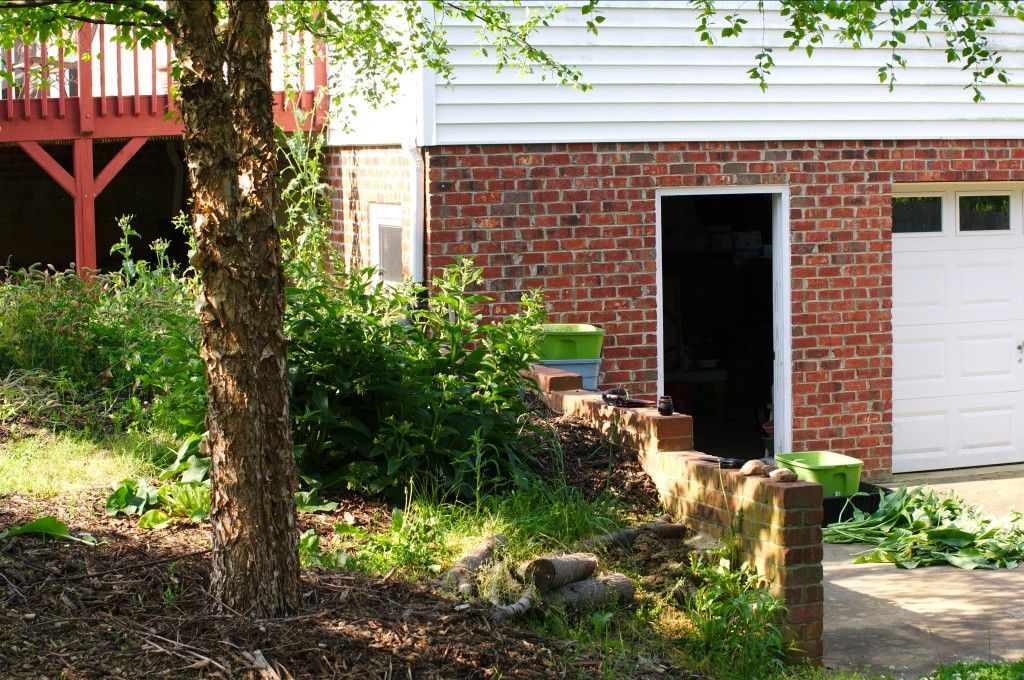
May 1, 2012. Harvesting three comfrey plants. One has been cut and can be seen on the right, with the other two still standing. We use comfrey for mulch, for bedding in the worm bins, and for making compost tea.
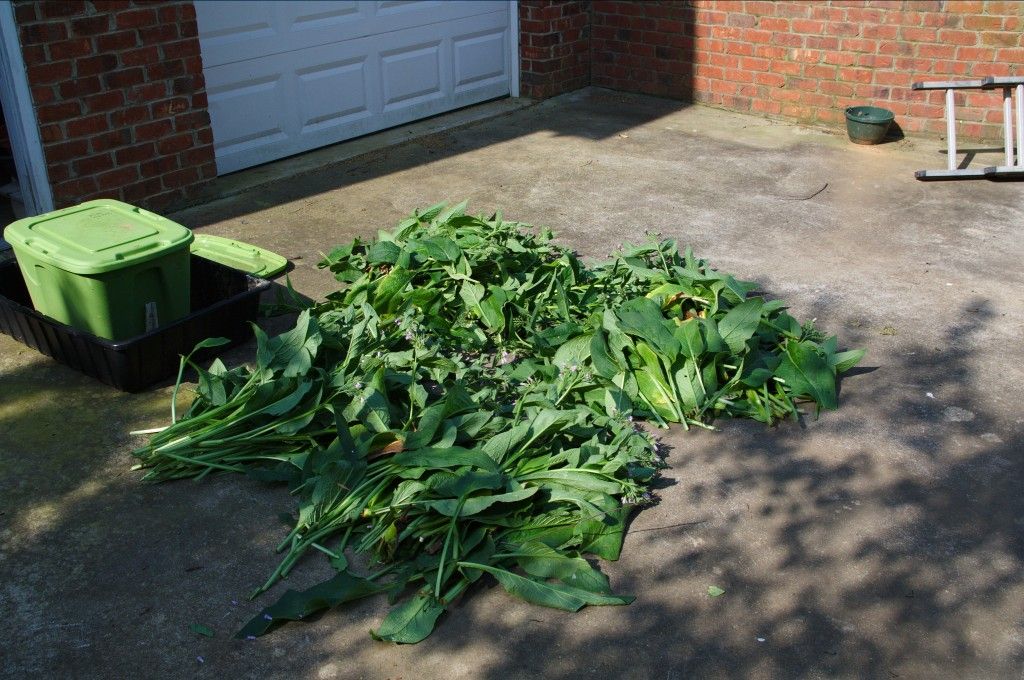
May 1, 2012. Biomass from three Russian comfrey plants- cut on the last frost date! What a mild winter.
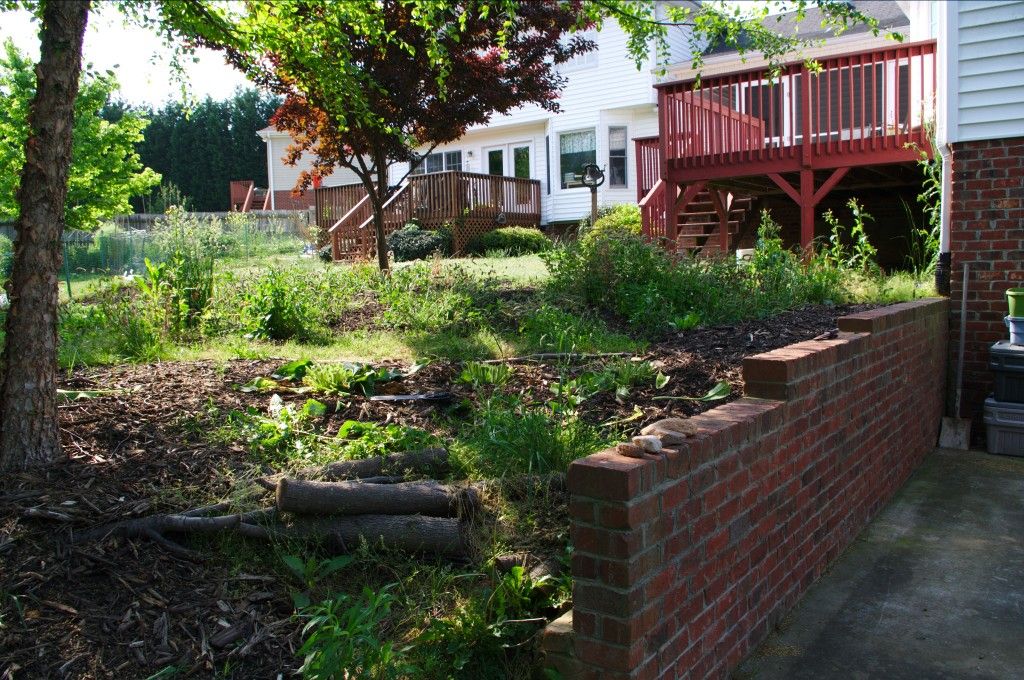
May 1, 2012. Gone! But not for long...
In our climate, comfrey can be cut at least once a month during the growing season (up to 7 times a year or so) after it has become established. This makes it a wonderful choice for mulch production. Chop and dropping is at once a maintenance strategy and a planned disturbance. It can be used to create gaps in a canopy to promote understory growth, as a method of slowing plant production, and for many other purposes.
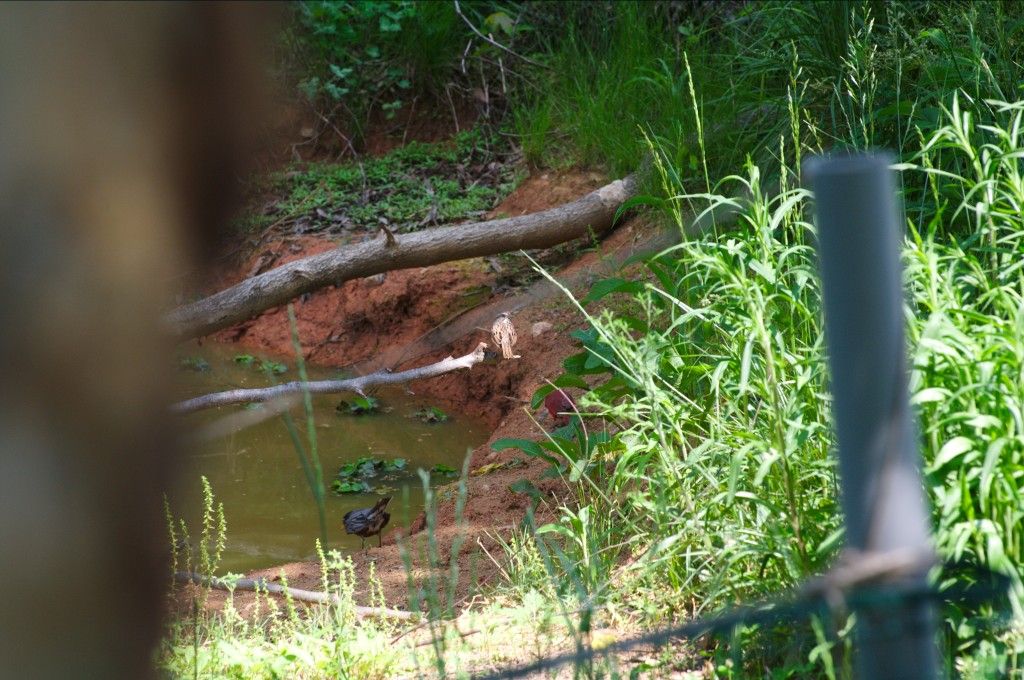
May 2, 2012. A cardinal, robin, and sparrow (?) visit the lower, larger pond at the same time. The local watering hole!
When you begin to provide a healthy environment, your garden quickly becomes a popular place with the locals.
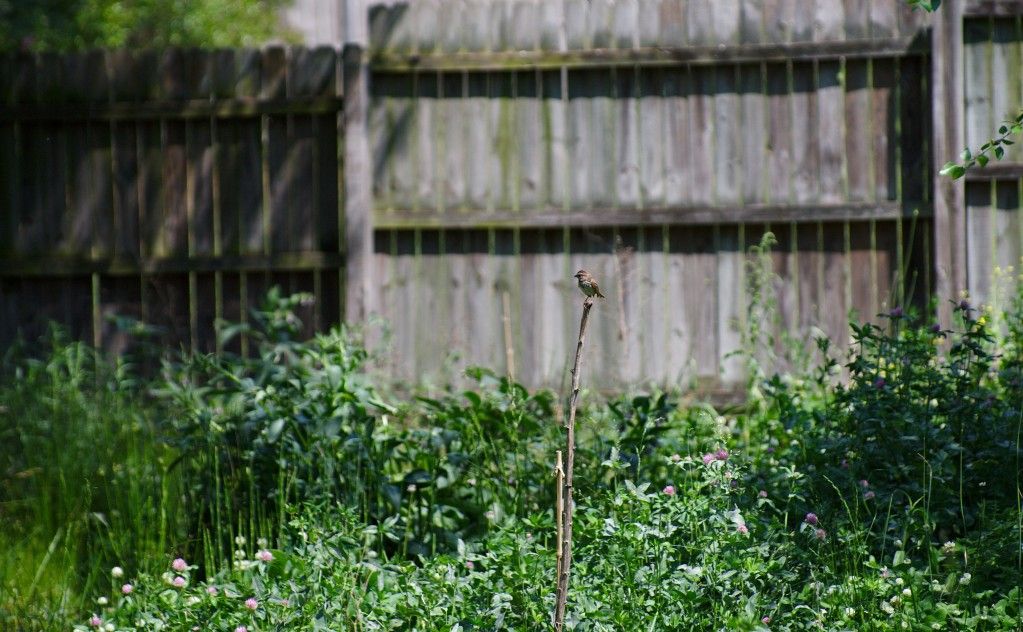
May 2, 2012. I believe this is a sparrow as well. This is why we leave things standing- they can be used as perches as well as habitat for insects.
And sometimes mistakes continue to be made- such as the following photo.

May 2, 2012. Just before leaving for a long weekend, I put down a loose layer white clover to mulch the seedlings in the south facing berm. What I didn't know is that they would rot down so quickly and smother most of them. Woops.
When chop and dropping, make sure you realize how your mulch will break down. Before applying to young plants, make sure you either a) take great care not to cover them or b) let the mulch dry before applying to avoid smothering.
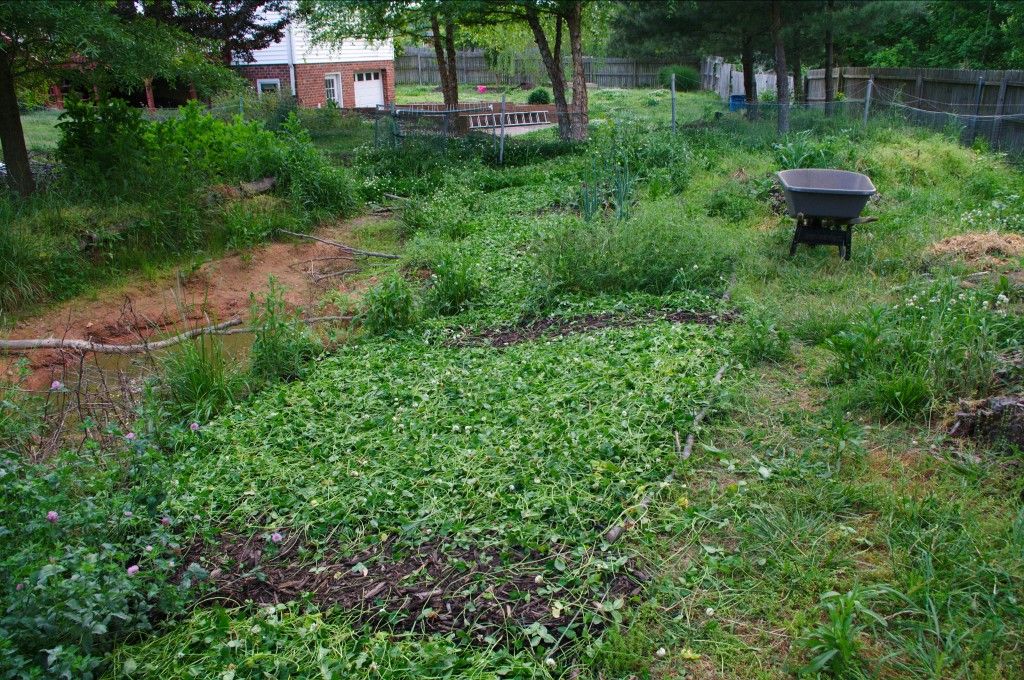
May 2, 2012. Same, but closer. It "looked" like a good idea at the time.
May 2, 2012. Snap shot before leaving. The red clover is now flowering, so it is almost time to chop and drop the cover crop.
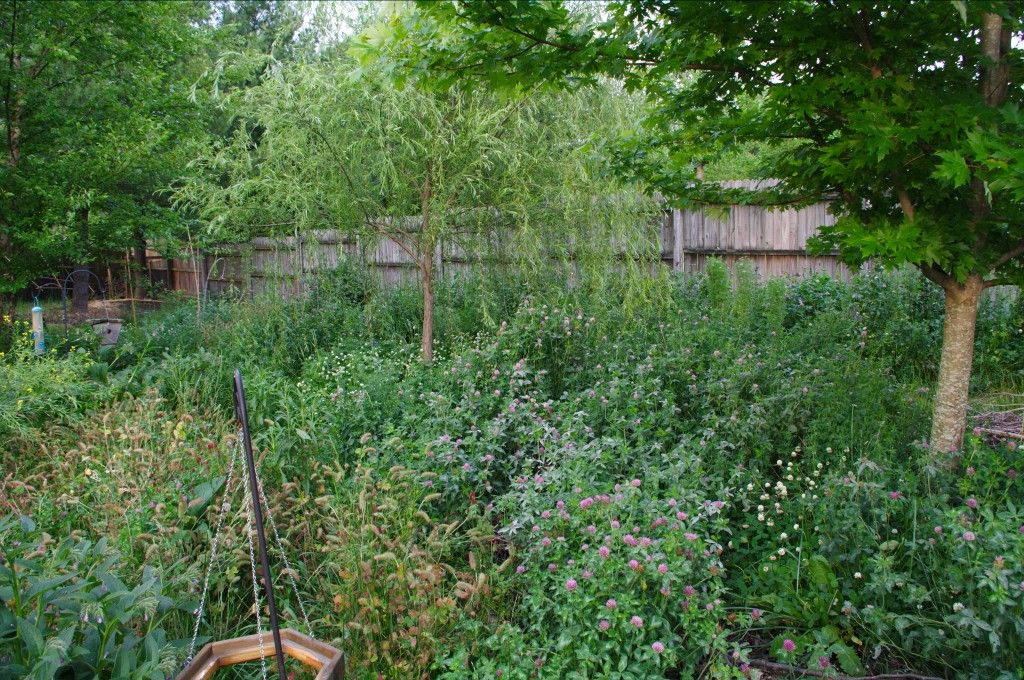
May 2, 2012. Little closer, quite a bit of generalist nectar available. Which is a good thing.
With the red clover and alfalfa now flowering, I'll be able to begin cutting it back. I wanted to have enough nectar available for an army of insects before disturbing the system.
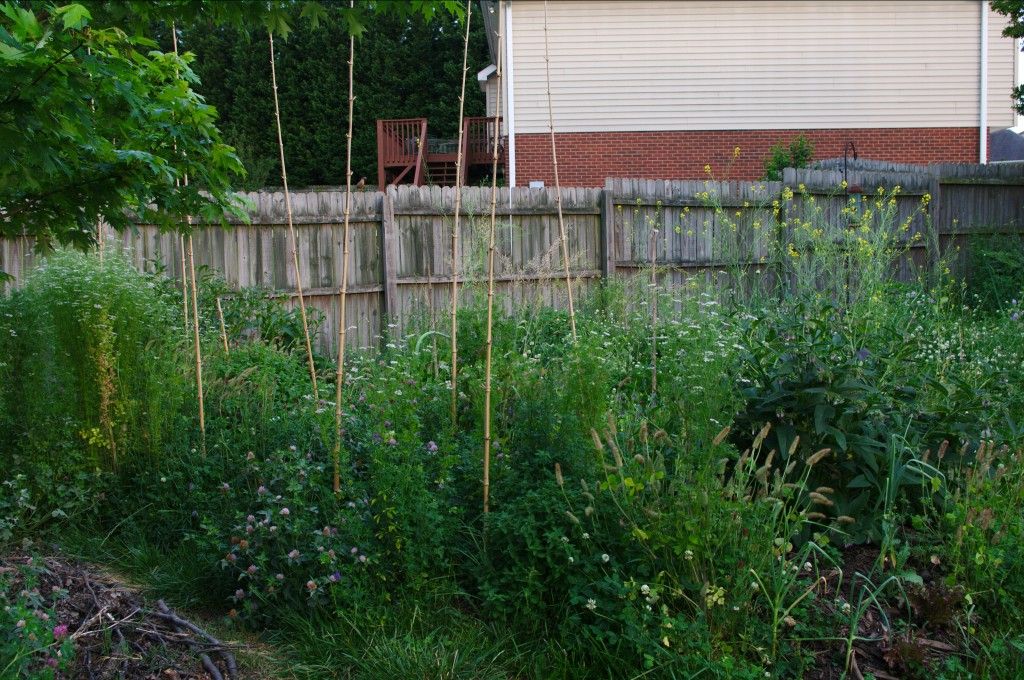
May 2, 2012. Cilantro provides an early abundance of food for specialist insects.
Not all insects can acquire food from the same sources. A lot of predatory species have undeveloped mouths and need readily accessible flowers, such as those from the above cilantro plants.
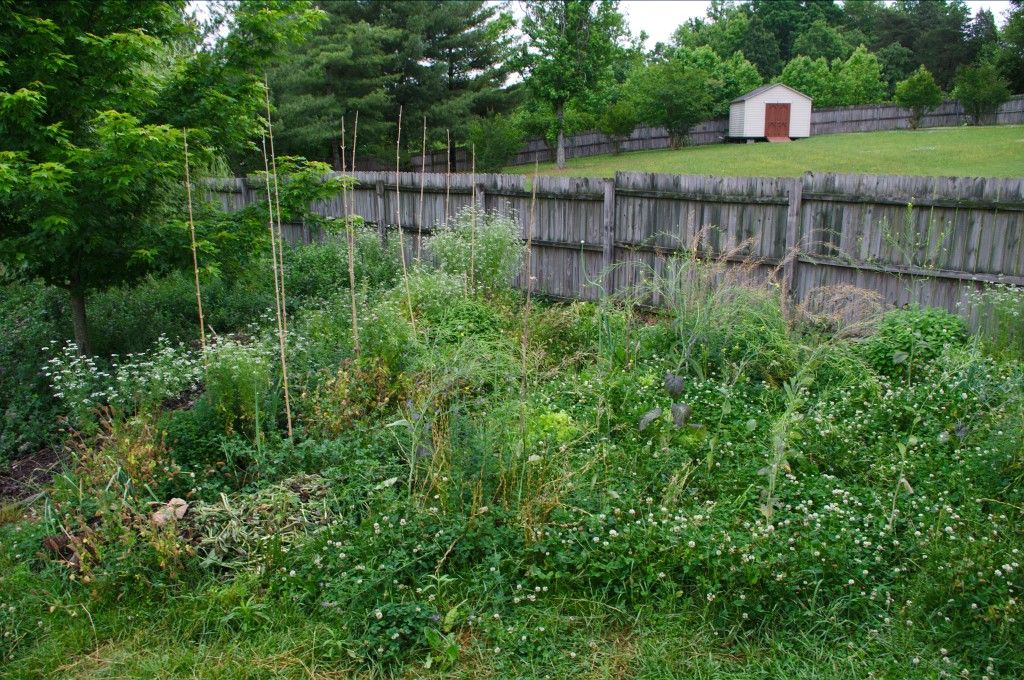
May 9, 2012. On return from our trip the garden has held up very well. This is the transition zone between the old green and nightshade guilds.
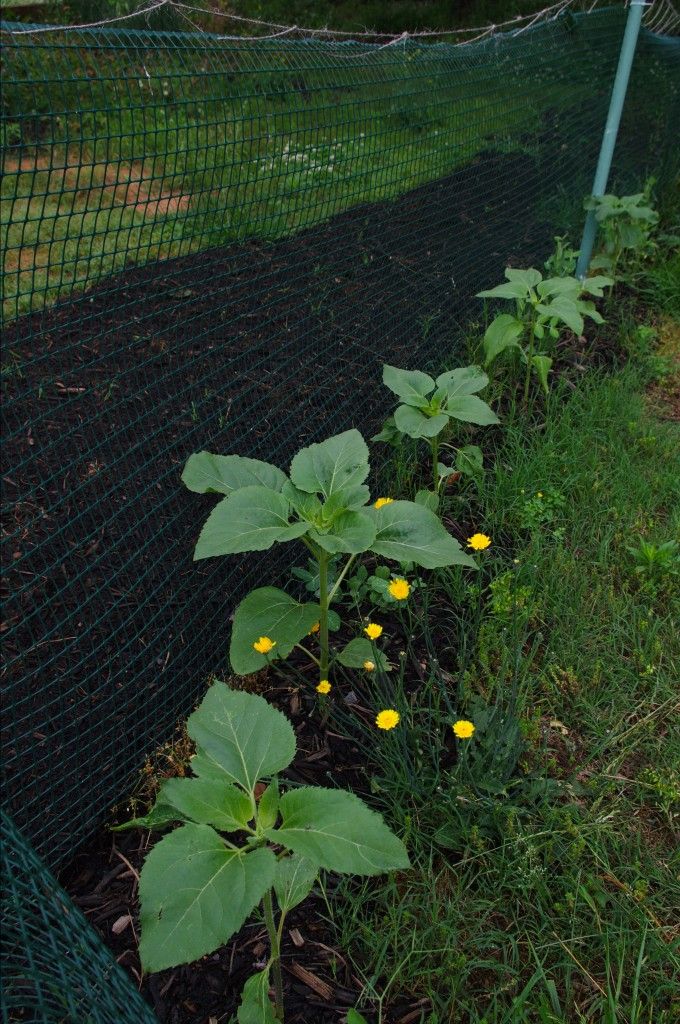
May 9, 2012. The sunflowers and peas we sowed along the fence are growing very well in this location as it receives more sun and water (due to being on contour) than some of the other mounds.
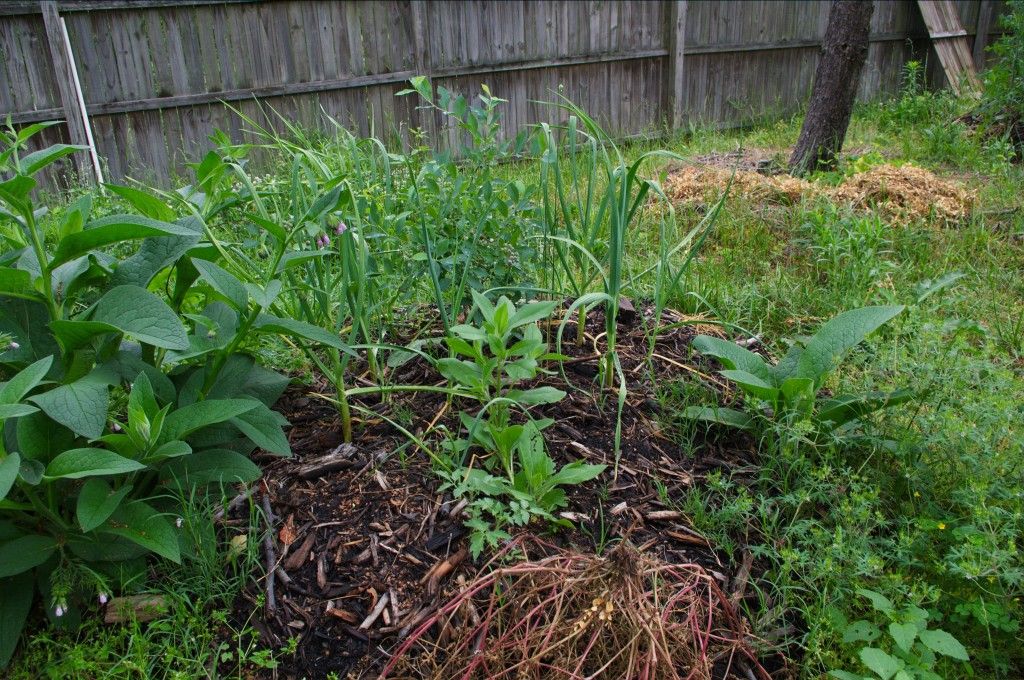
May 9, 2012. One of the blueberry mounds. Tomatoes, black eyed susans, comfrey, and garlic are our desired species here- of course there are others too.
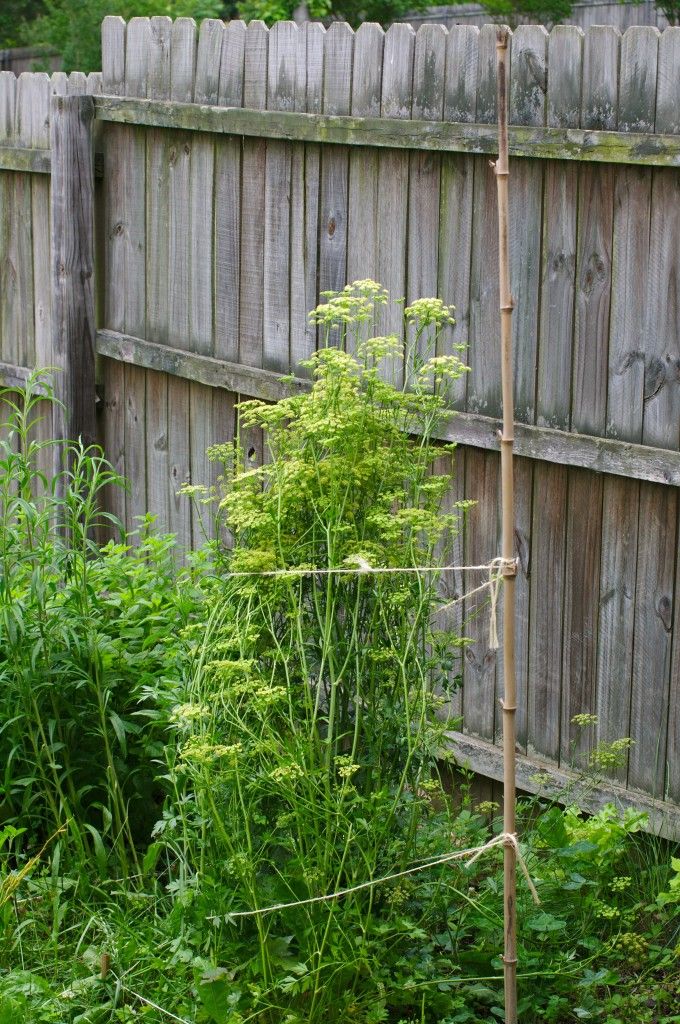
May 22, 2012. Parsley comes along a little later and is quite the popular choice for specialist insects. Although we only had about four parsley plants from the year prior, now we'll have hundreds of seeds to spread throughout the garden.
Allowing plants to live our their life cycle is an important aspect of ecological gardening. If all we ever know are the periods in which a species produces food for us, we will not begin to understand all of its requirements nor its ability to provide for us. Going into its second year, the above parsley plant has an entirely different form than its first year and will feed many beneficial insects as well as produce enough seed for years to come.
Again, beauty is in the eye of the beholder. Take the following photo for an extreme example. No one "in their right mind" would mulch a bed with material that looks like that... or would they?
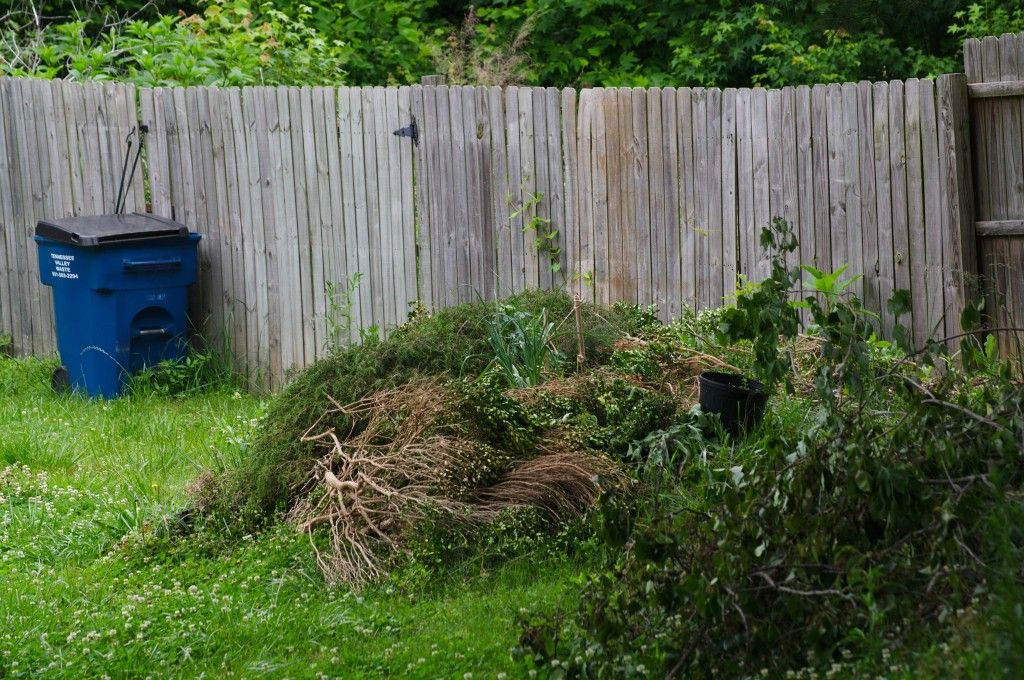
May 22, 2012. Having done some yard work for a neighbor, I took the cuttings home to use as bulk-sized mulch. We had a lot of evergreen/acid material so I used this to bunker down the berm extension- which has a southwest facing aspect. I knew that we would have a hot summer, but no idea it'd turn out to be the worst drought since the 30s. Anyway, my hope was to 1) cut down wind drying out the bed 2) act as a hide for insects and 3) a slow decomposing layer of mulch. The large bunch of branches in the foreground is acting as a wee little wind break for the rest of the garden. Note- our specific location has been largely spared from the worst of the drought.
So think again. Do we want something to look tidy, or do we want resilient systems that can withstand shocks?
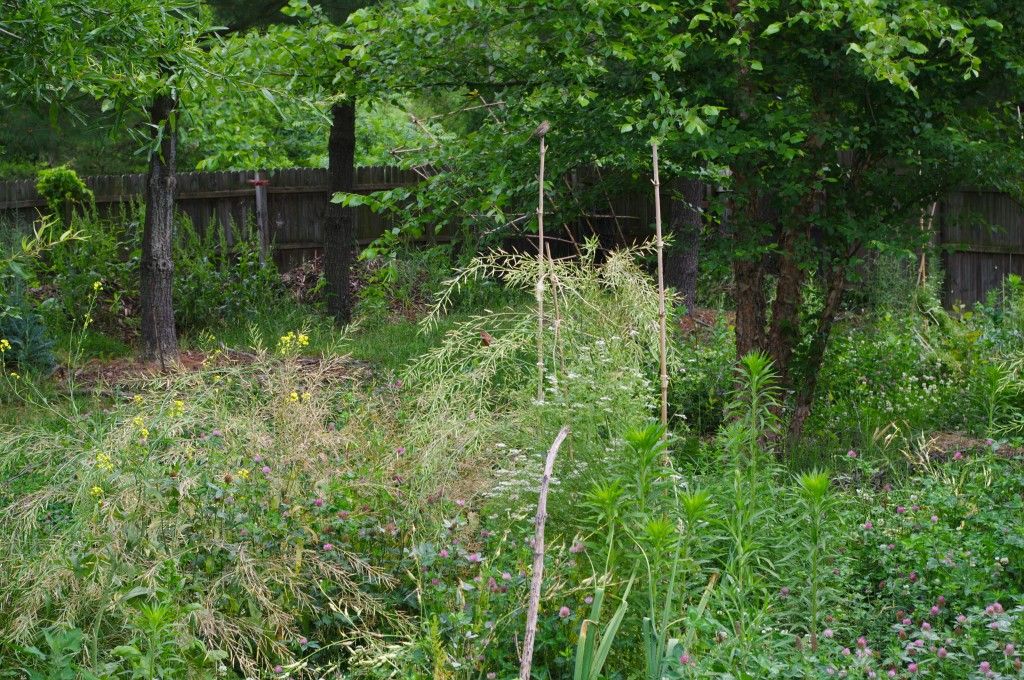
May 22, 2012. One of my favorite photographs- we have at least three species of birds in one shot! A finch is occupying the mustard plants devouring seeds, a cardinal is swooping in (center left, red blur), a gold finch is hidden among the branches of the birch, and what could be a sparrow is perched upon a bamboo pole.
Yes, there is nothing like seeing a diverse set of creatures enjoying different aspects of the garden. Sometimes you can capture them all in one frame. But those seeding brassicas are ugly you say?
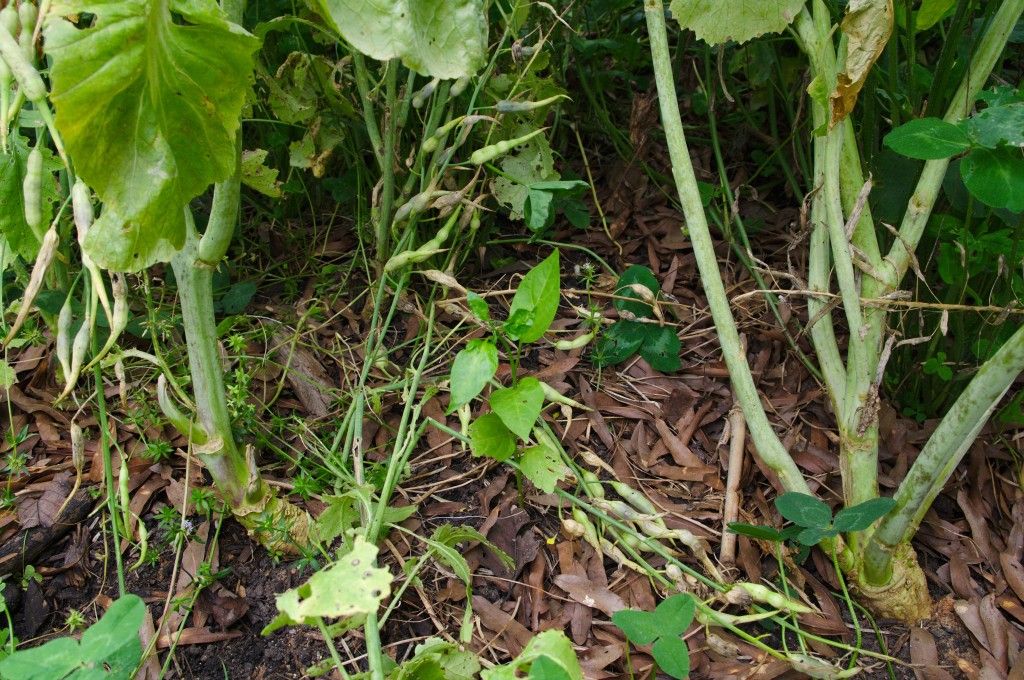
May 22, 2012. A pepper transplanted below a few mustard plants. While it'll take a while to gain some footing, the partial shade from the overstory of mustards keeps it from being stressed from the sun quite as much.
Not when you are stacking functions. Acting as a canopy, they shelter transplants. By bringing in birds, they fertilize the crop growing beneath.

May 22, 2012. The transition zone between the old green and nightshade guilds.
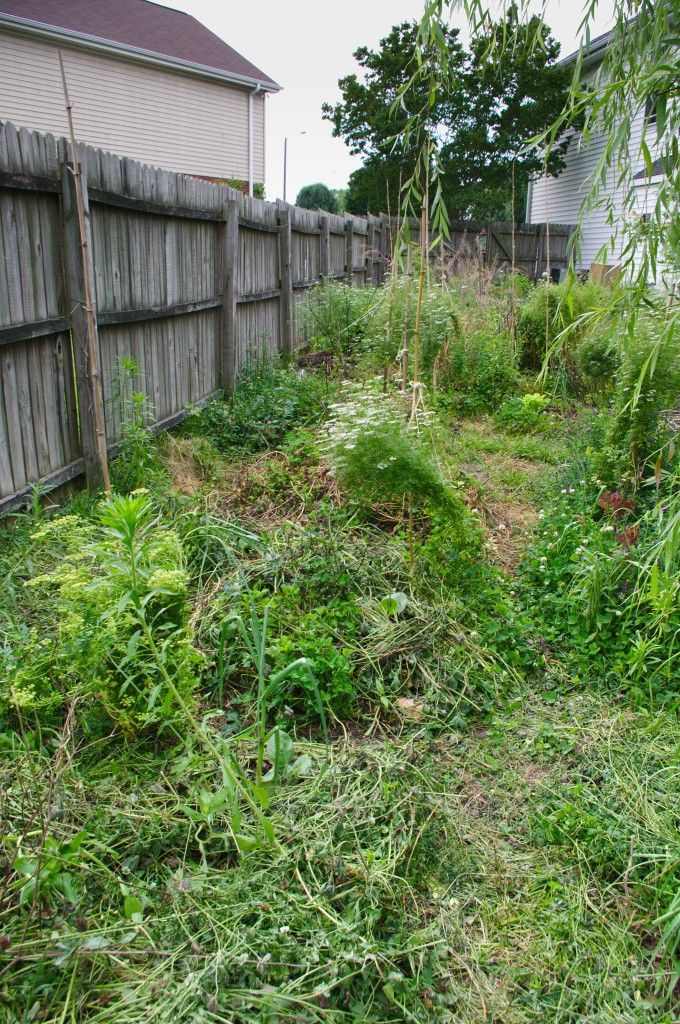
May 22, 2012. Chopped and dropped red clover and alfalfa in the old nightshade guild. They regrow quite fast so a few times a season isn't out of the question. And since it takes a while to make sure we aren't cutting down other plants at the same time, this allows for quite a bit of flowers to be available throughout the cutting season. In other words, by the time we reach the end of the garden, the earliest cuttings are flowering again.
Thickly cut mulch also becomes another habitat for creatures- especially spiders. Diversity in garden structure can change during the growing season, resulting in a dynamic ecosystem.
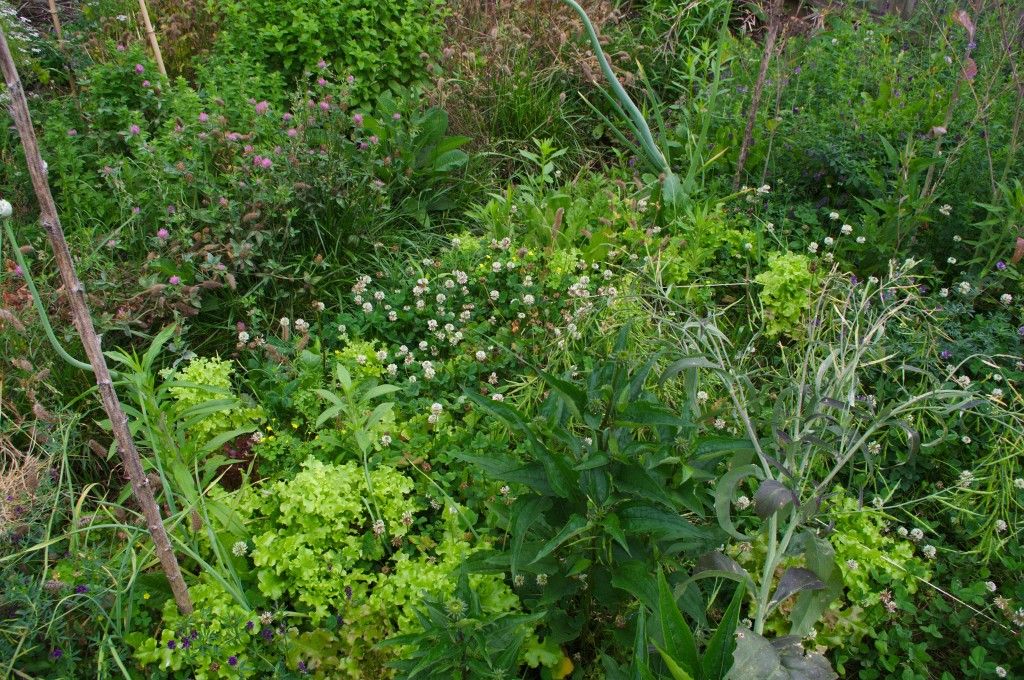
May 22, 2012. Back to the transition zone at the upper, first swale. Self sown lettuces doing well in a mixed cultivation with echinacea getting ready to put on its flower display.
Our initial choices for cover crops are tried and true around the globe: alfalfa and clovers. We could rely upon them to establish quickly and produce results. With the system stabilized by these workhorses, we can then begin to insert native nitrogen fixers to replace them. These will vary structural diversity, different types of flowers, root structure, and many other factors. Not only that, but some (such as New Jersey tea) are edible.
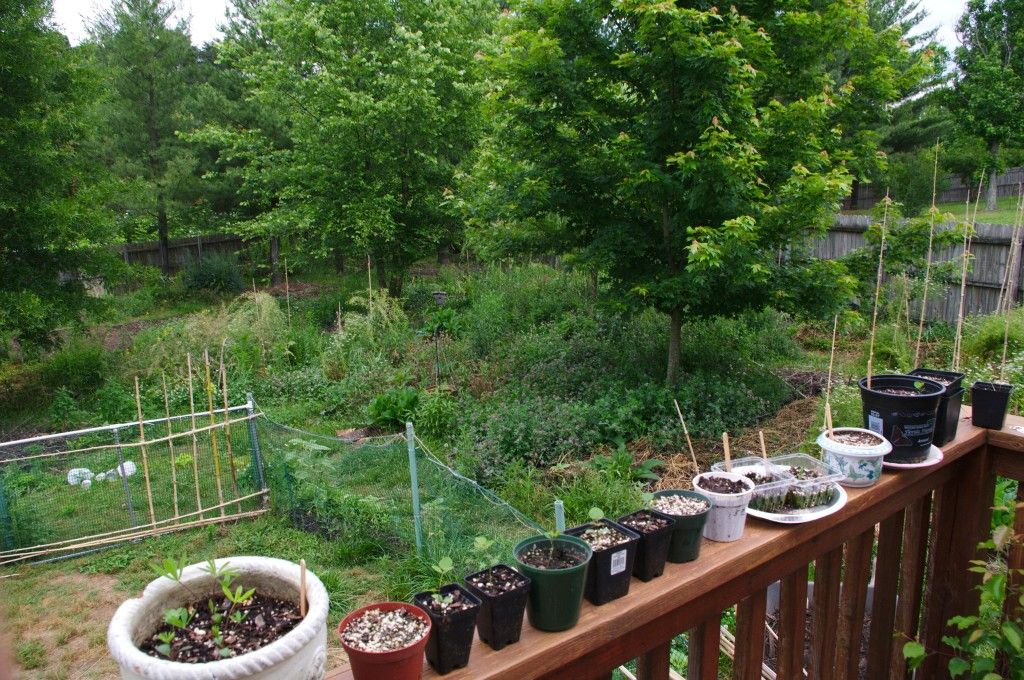
May 22, 2012. Some of our native perennials growing out to size before transplanting. They include three Baptisia (indigo) species, Thermopsis caroliniana, Robinia pseduoacacia, Amorpha fruticosa, two species of Lupines and some others...
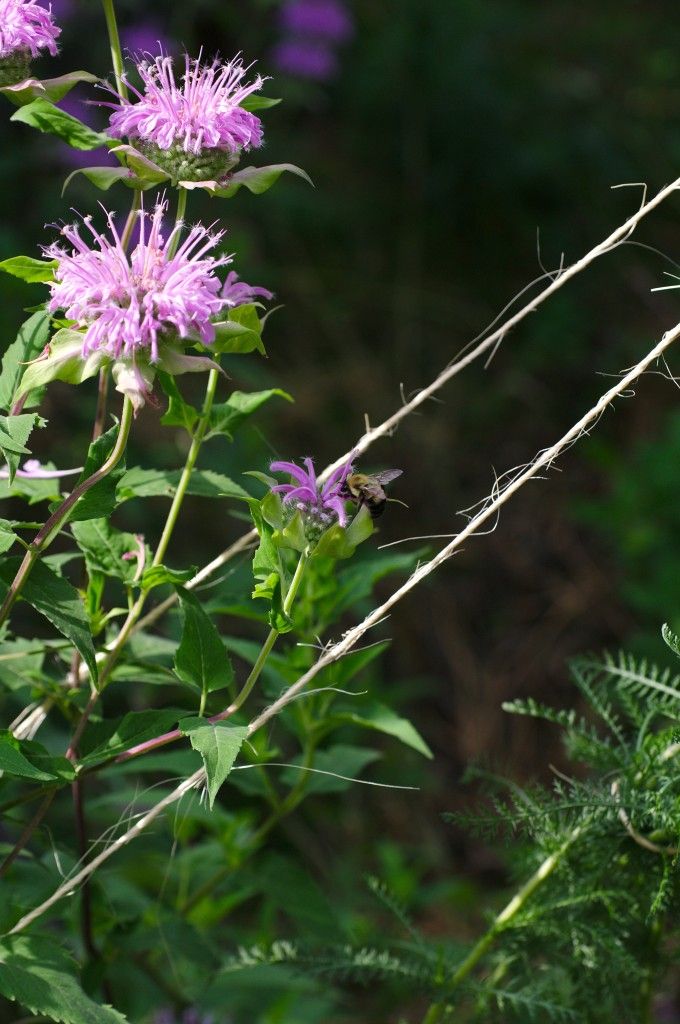
May 29, 2012. Bee balm looking nice- leggy, but still healthy. We cannot wait for the other three species of Monarda to take off.

May 29, 2012. Same location as the other chop and drop one week later. Like I said, it doesn't take long for them to regrow!
One week later from cutting we have foot high red clover and alfalfa. We will be able to cut these beds probably three times a season. The resulting accumulation of biomass in the soil and litter above will bring us closer to our goal of a thriving soil food web.
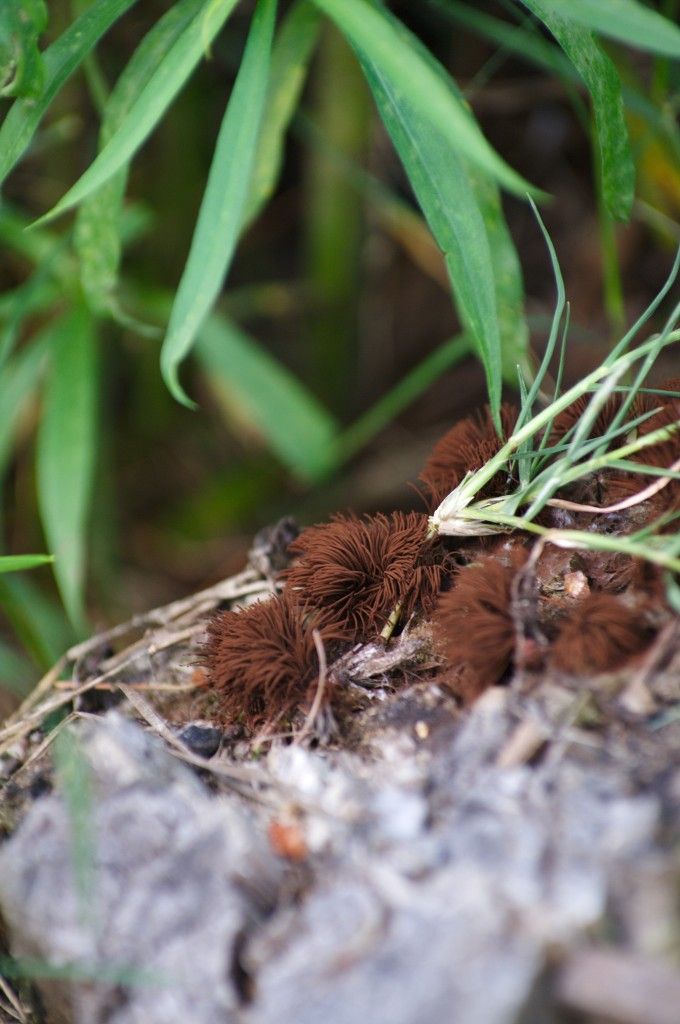
May 29, 2012. Now that is wild fungus! No idea what it is. Growing on a pine stump we chopped down November 2010.
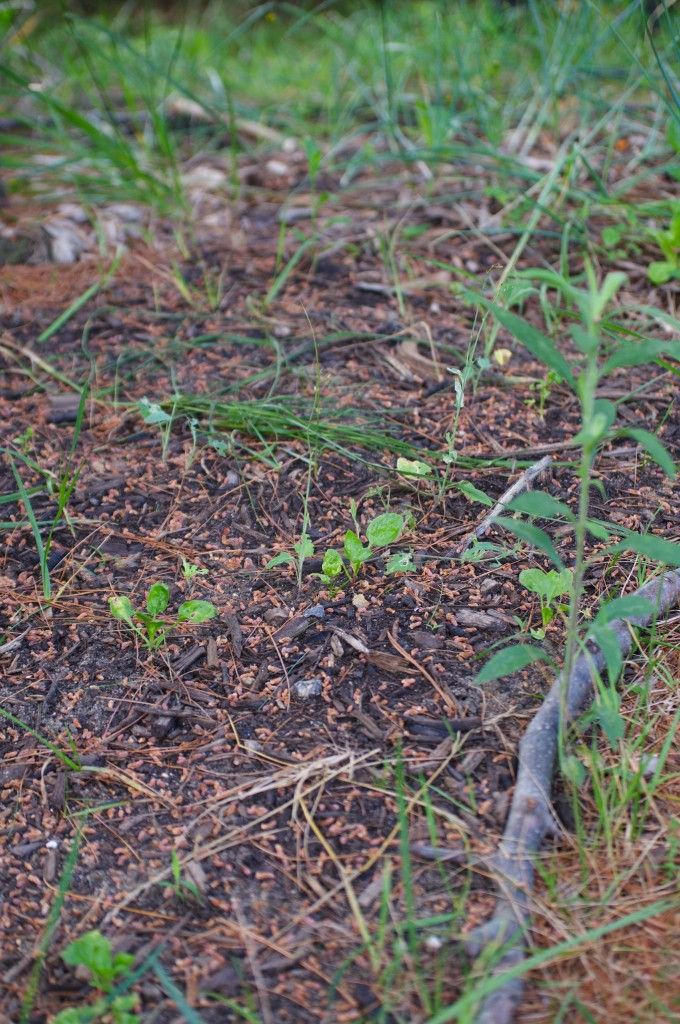
May 29, 2012. This is an experiment that didn't do too well... cool season crops sown under a pine tree during the summer. Thought I'd give it a go, and they didn't fare very well at all. Probably needed more water besides the lack of light.
We experiment for fun and for hopes that a success will be realized. But we will always learn even if an experiment fails. Now we know to only sow these crops in spring- when the sun's rays will reach these beds for a few hours each day. They cannot establish with light filtered through a dense canopy.
Another experiment coming into its own. After smothering the early emerging seedlings with the mulch earlier in May, summer crops begin to emerge. This bed was sown with a seed mixture that included annual vegetables and perennial cover crops. The mix was broadcast over the entire area instead of painstakingly setting each seed out. When spacing became apparent, we could transplant some of our perennials into open places.
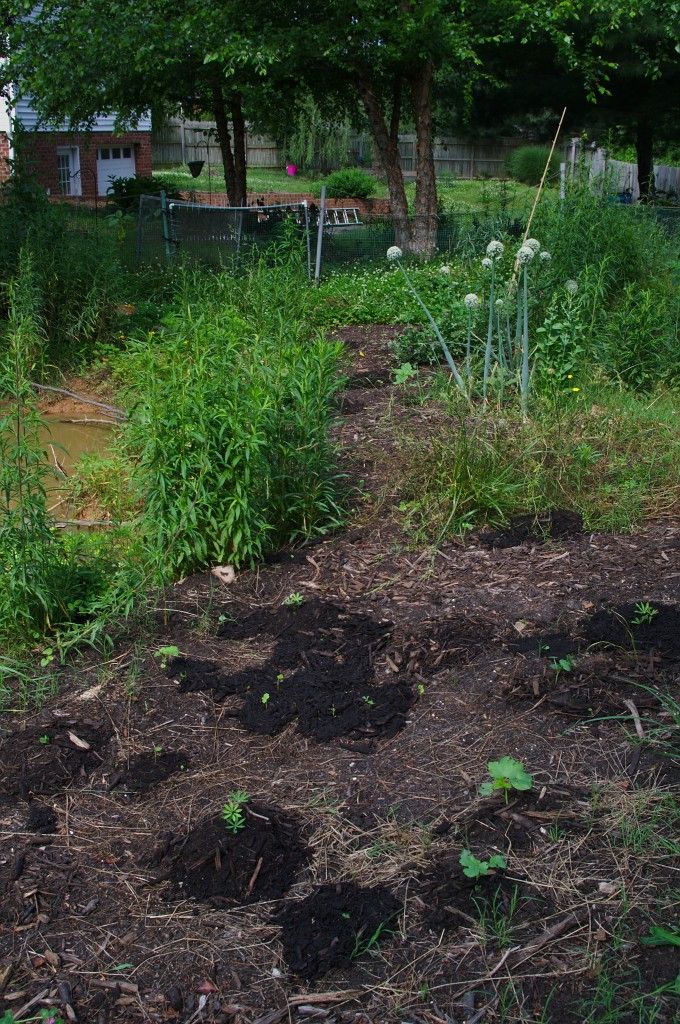
May 30, 2012. The sheet mulched bed with transplanted natives, among other crops. We took to soaking our mulch in a bucket before putting it on. Seemed a lot easier than standing over it with a watering can waiting for the wood to become saturated. The squash produced prodigious amounts of food this summer.
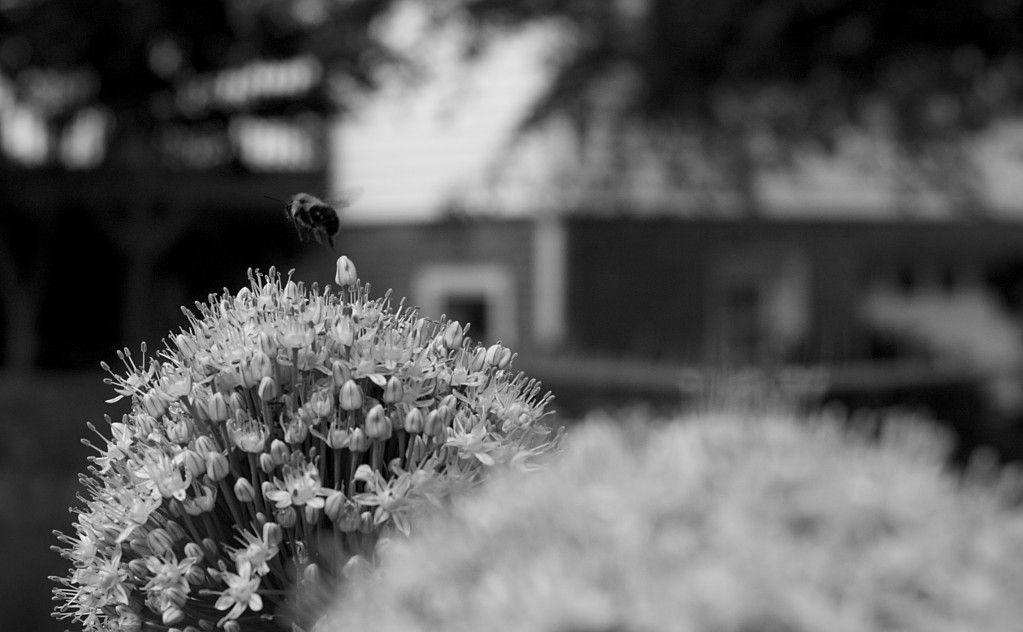
May 30, 2012. Bumblebees love onions.
I was still itching to plant more vegetables, so we claimed one of the mounds for cucumbers and tomatoes (as the main crop).
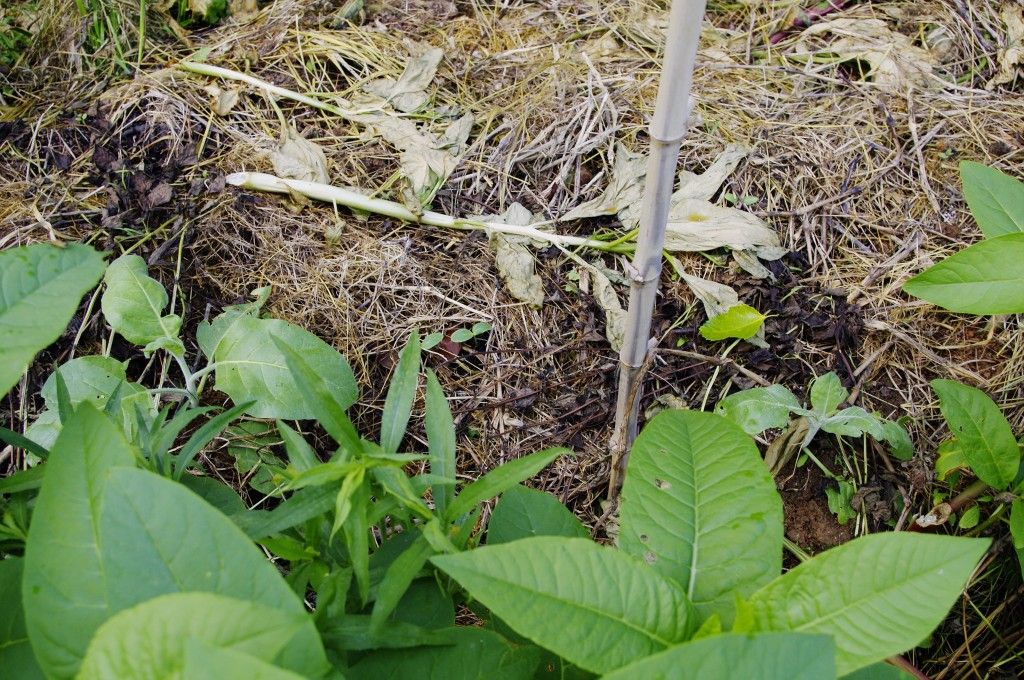
May 30, 2012. Cucumber seedlings, among other veges and herbs, emerging in a newly established bed.
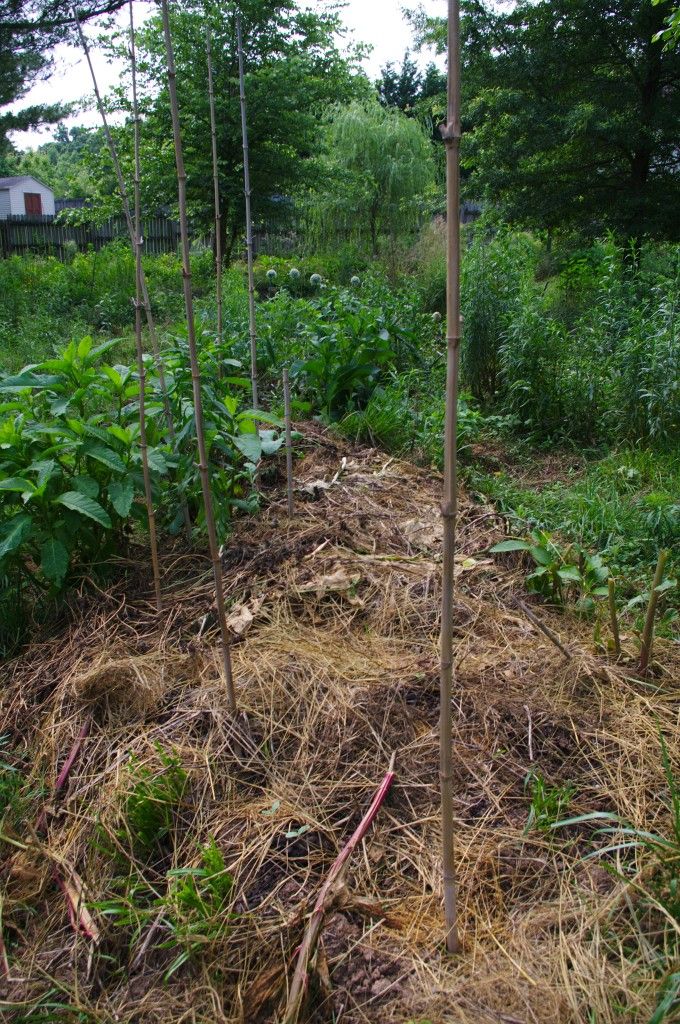
May 30, 2012. A view of aforementioned bed. It had been growing copious amounts of chickweed over the winter, which I chopped and dropped regularly. The soil was soft in this minihugel mound and we put mini terraces and little pools for water to stay in when it rains (or when we water). Cucumbers, tomatoes, and sunflowers were the main crop with many other herbs making an appearance.

May 30, 2012. While we are happy to see bees and other pollinators, we cannot help but to feel that if neonicotinoid pesticides were not used by our neighbors that we would literally be humming with bees. Unfortunately, people do not know what they are using. At my place of occupation I regularly informed customers that it was being banned abroad, but the stuff still flew off the shelves. Systemic pesticides are "easy." An easy way to kill off the bees...
Neonicotinoid pesticides are a serious issue. The above plants are called bee balm. Twenty years ago, they would have been literally humming with bees. Now, after almost a decade of home owners buying these systemic pesticides (among other stressors), our bee population has been reduced to almost nothing. We cannot do this alone, we need our neighbors to step up and begin providing a safe environment for life on earth.
June 1-16 2012
My flight left for Finland on the seventeenth, hence only half a month of June.
Thick vegetative ground cover in conjunction with mulch means our system will retain water for much longer than bare dirt. The plants can look after themselves through dry weather- but not extreme drought of course.
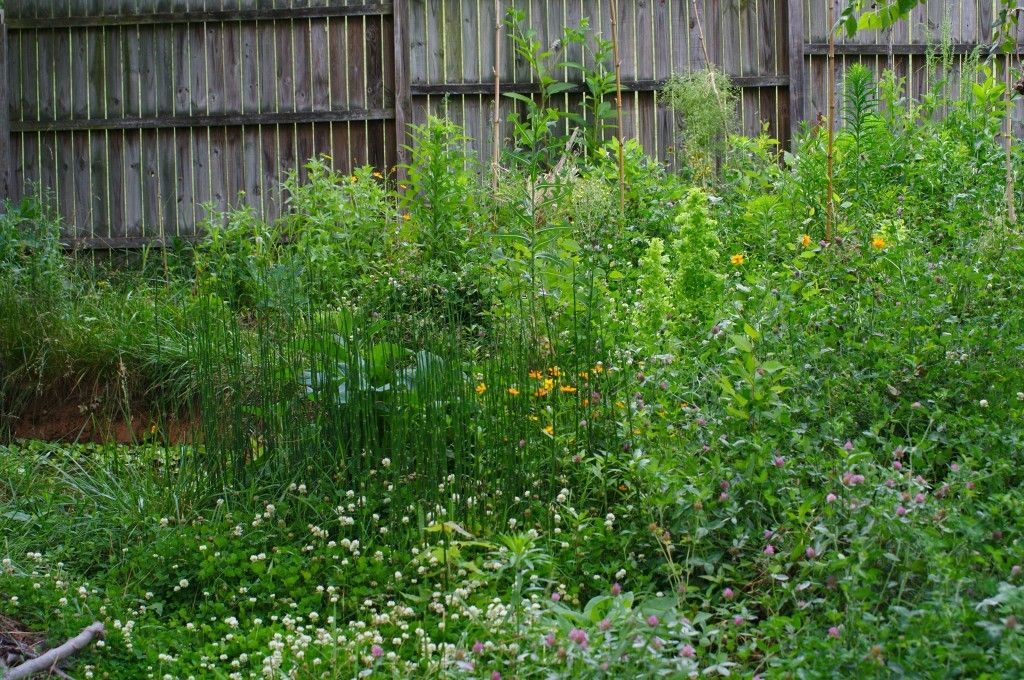
June 5, 2012. How do you clean water before it enters a pool or pond? Vegetation! The more vegetation, the less run off and the cleaner your water will be. Even better, the more biomass accumulated into the soil the slower the water will move through the landscape. While we may want our ponds to fill and fill fast, they will stay full longer as long as we continue to increase the organic matter in the soil.
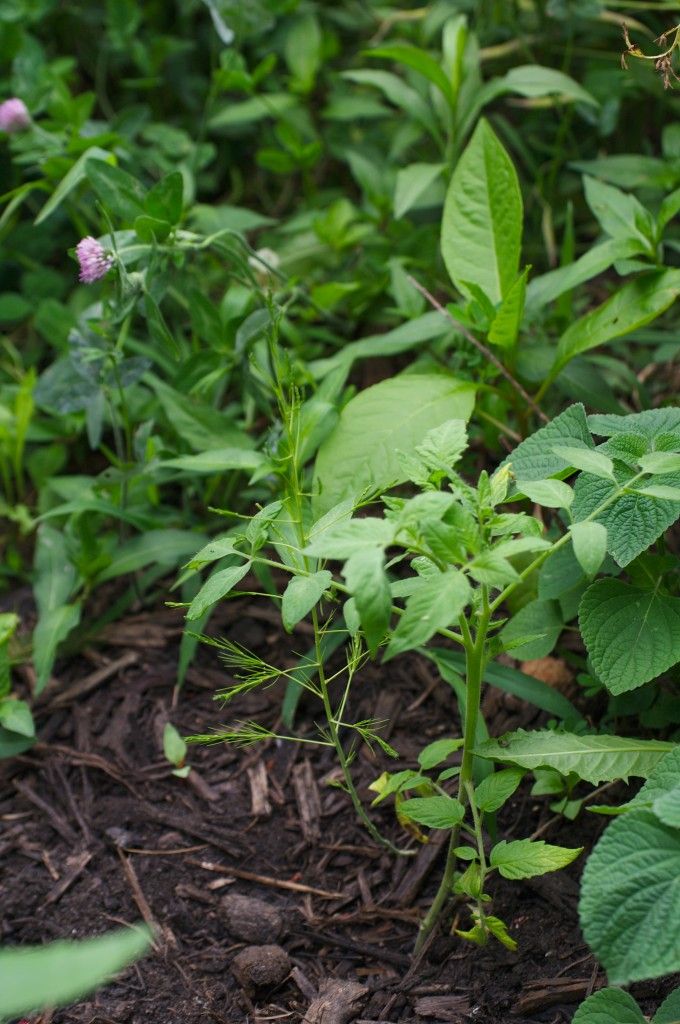
June 5, 2012. Two gifted plants- asparagus and a tomato. We were fortunate enough to meet a few other like minded people in the area and they were happy to share some gifts with us (and vice versa!).
Asparagus needs a lot of space, but we figure that since it takes years to establish a root system we can allow it to have some competition in the mean time. If we want the plants to produce a lot of asparagus we can chop and drop its competition.
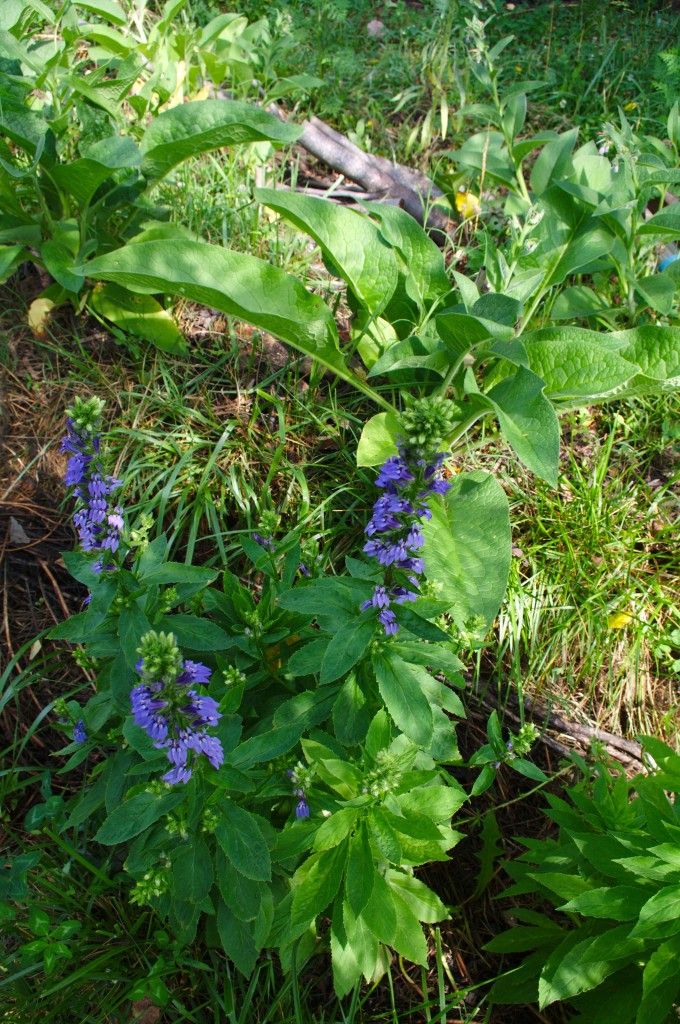
June 13, 2012. Comfrey and great blue lobelias occupying two different niches along the second swale. The GBLs will occasionally be flooded when the swale fills completely- mimicking their preferred soggy habitat. Russian comfrey enjoys a steady supply of water and is placed on the downslope- its strong roots holding soil and accumulating nutrients as they wash into the swale. Both produce beautiful flowers!
The above image demonstrates how differing water requirements can be met within the space of a few feet by paying attention (and creating water harvesting earthworks of course!)
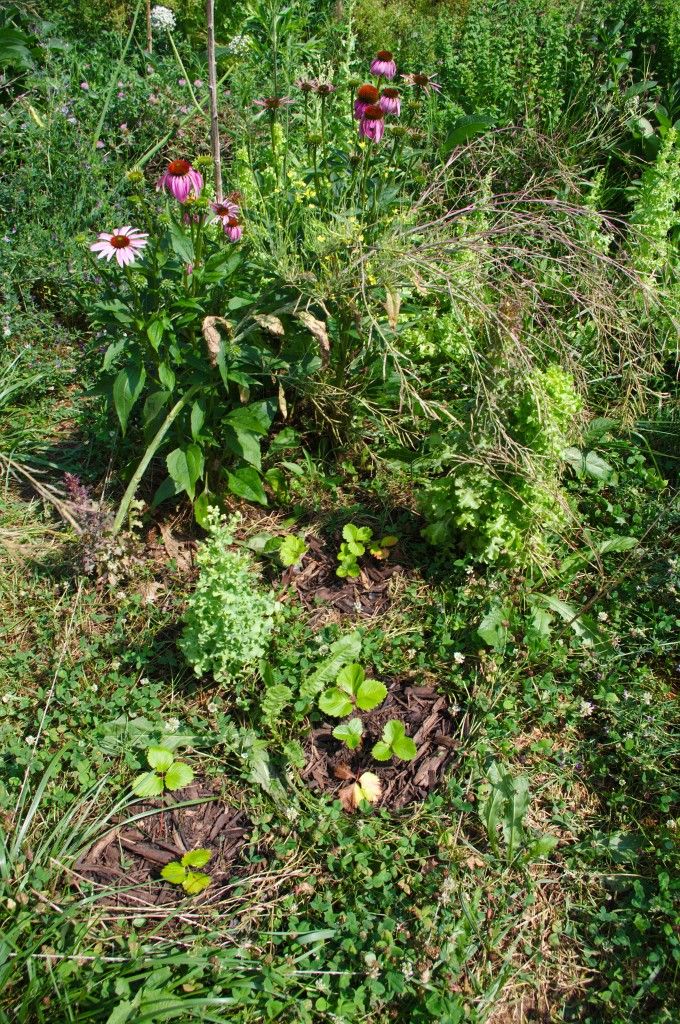
June 13, 2012. We were also gifted almost thirty strawberry plants that couldn't find a home this summer. So we experimented by putting them in full sun, partial shade, and elsewhere. My family report back that they even produced some strawberries for us in the first month of transplanting.
Strawberries, even the cultivated strains like this one, serve as a great perennial ground cover. More wild varieties have longer bearing years and are more resistant to disease. Eventually we will have multiple species of strawberry growing in the garden.

June 13, 2012. This was a surprise: what I believed to be dead or dying mustard plants decided to have another round of flowering. Just incredible to see them continuing in their efforts to produce offspring.
I had never heard of resurrecting mustard before I saw it with my own eyes. Nature is never ceases to amaze.
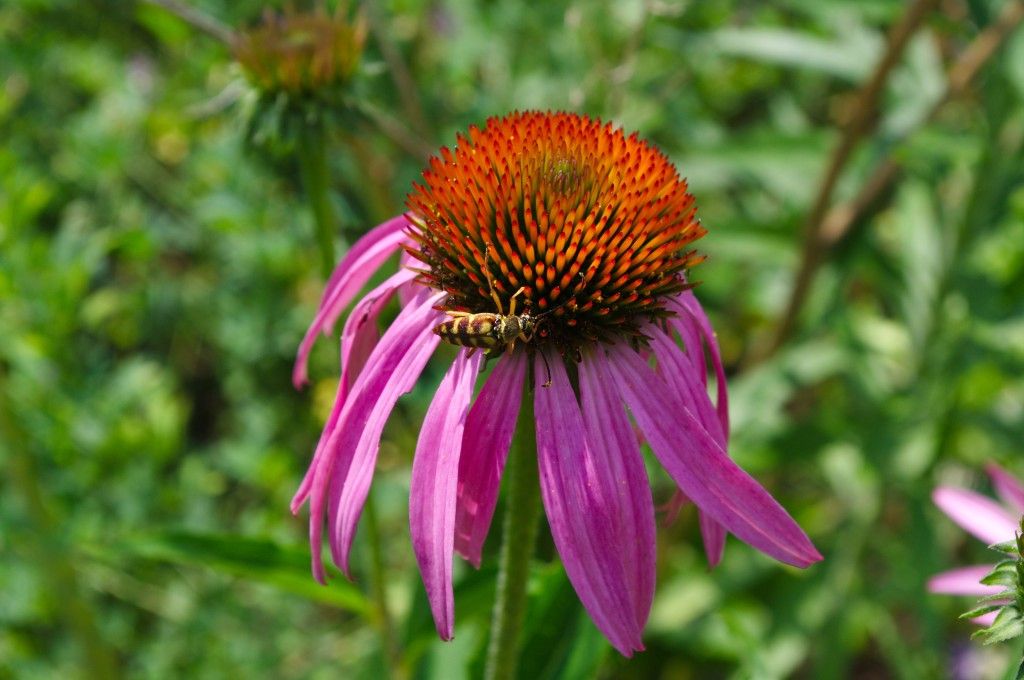
June 13, 2012. I believe that echinacea must be medicinal for other creatures as well as ourselves- and even if it doesn't- it'll delight the insects regardless.
I don't pretend to know every creature in our garden. But drawing them in is only the first step towards understanding our neighbors.
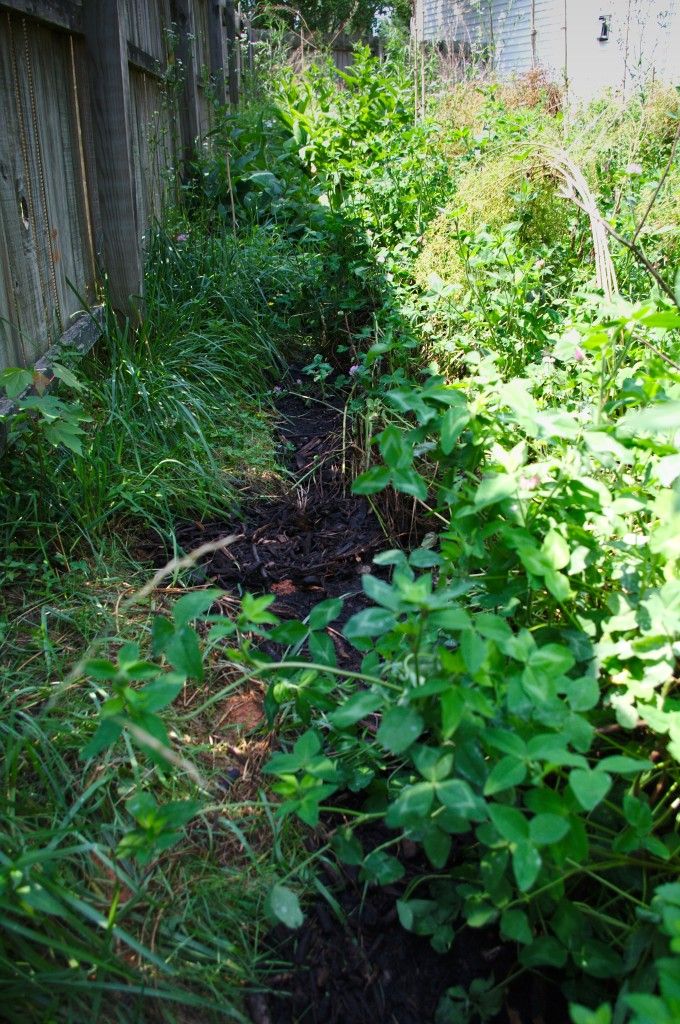
June 13, 2012. Now this was an experiment inspired by Yacouba Sawadoga's methods of digging holes and filling them with compost to amend the soil.
While we may not live in a desert, I figured that sinking water storage into the ground could be a good way to turn the "overflow ditch" I had dug in 2011 into something useful. So, out comes the shovel and I dug 20-30 gallon holes and filled with water logged mulch. By stepping them down the side of the fence, we could absorb large amounts of rainwater without putting in potentially dangerous holes.

June 13, 2012. Part of the south facing berm with all sorts of plants growing in the first year.
Nothing like seeing tomatoes grow in the most unlikely places. In the shade, these volunteers didn't need any regular watering.
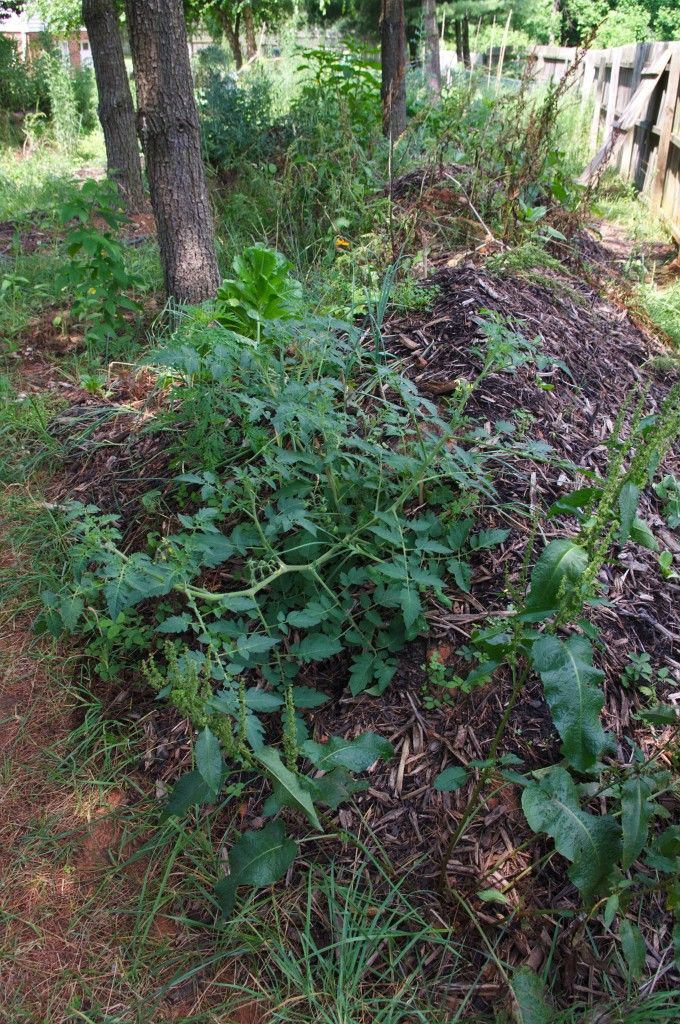
June 13, 2012. Volunteer shade growing tomatoes that fruit. Who knew?
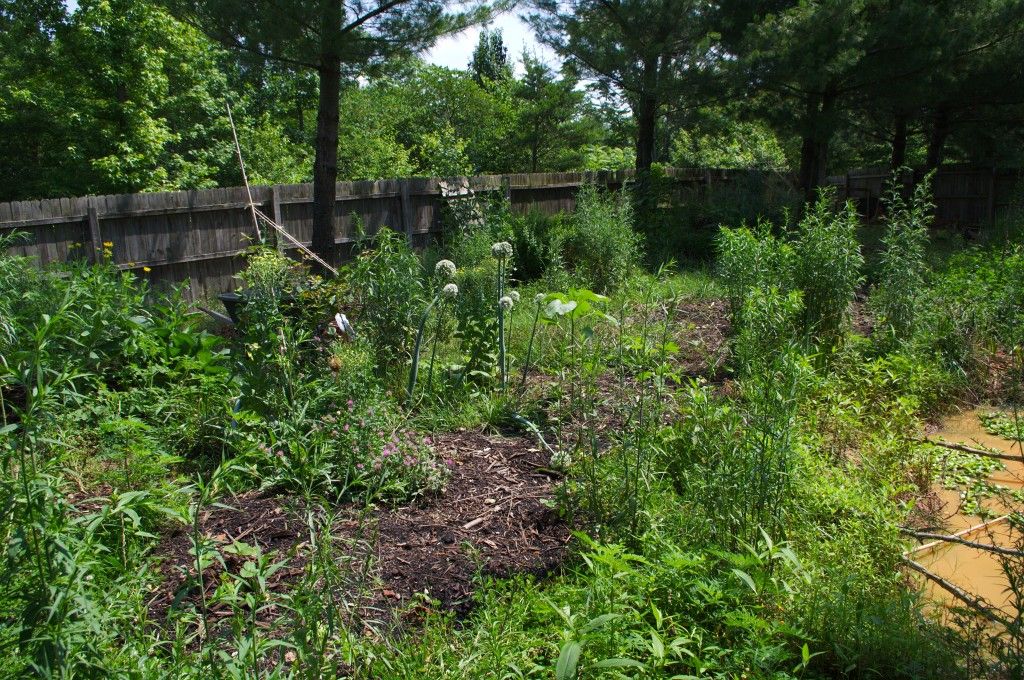
June 13, 2012. Another view of our new addition to the garden. The next step is to bring in more aquatic and marginal plants to clean up the water and improve the ecosystem services the ponds can provide.
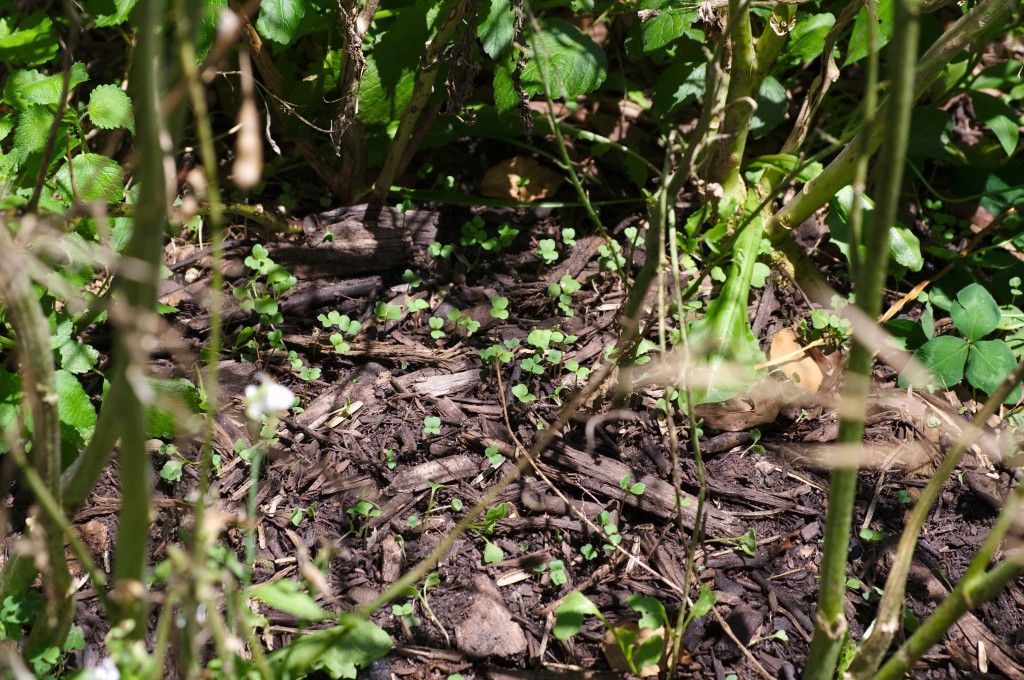
June 16, 2012. Birds can't eat every last seed. Or, maybe sometimes they can but not here. The seeds get lost in the mulch and are free to sprout. Fooled by soil cooled by mulch, these brassicas believe that mid summer is a good time to grow! We are hoping enough seeds were smart enough to remain dormant.
What joy the next photo brings:
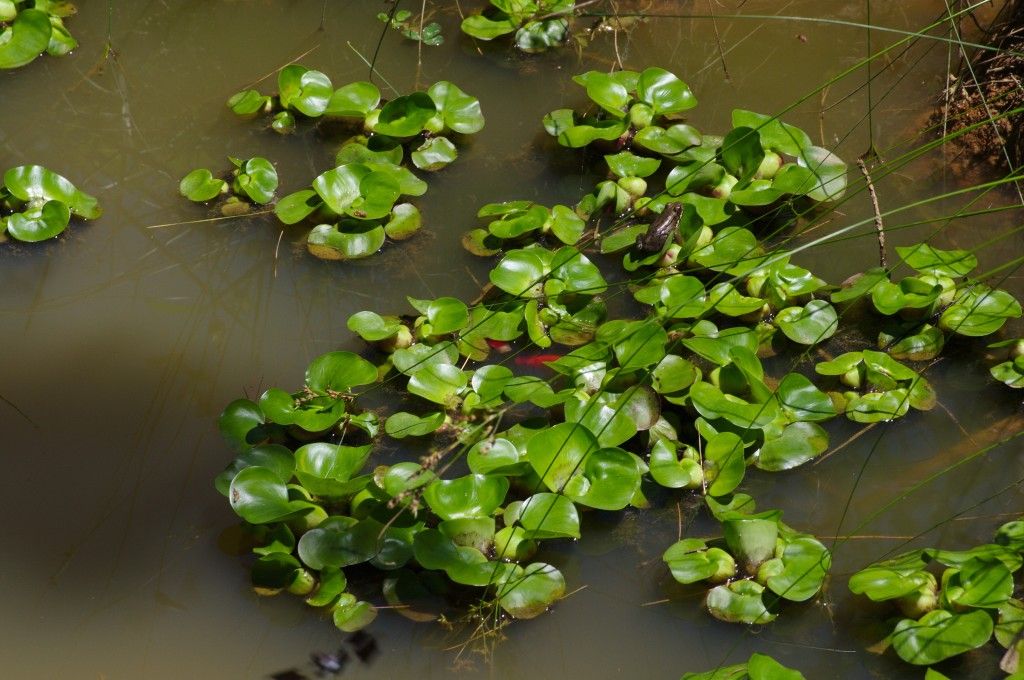
June 16, 2012. Another frog has taken up residency in the upper, smaller pond. This must mean our supply of food enough for the two frogs to tolerate one another.
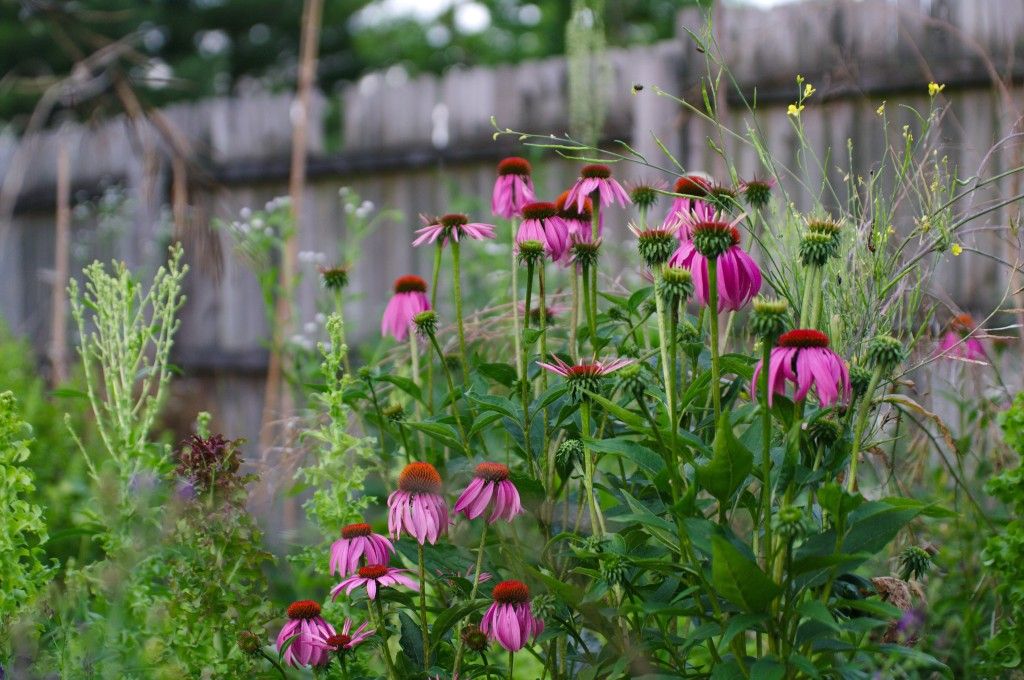
June 16, 2012. And lastly more echinacea along with lettuce flowering. These lettuce plants will produce the second generation of lettuce grown on site.
Conclusion
In half a year, we have greatly increased the biodiversity on the property. Niches have become more stable and more open on a monthly basis. Accumulating nutrients, water, and life onto our small plot of earth may not stem climate change. But it may inspire others to make a change. After all, we must be responsible for our own actions. Our property is now on the path towards resiliency and that is something we can rejoice in.
As I receive updates from the family I will be sure to post their results.
Cheers,
You must be logged in to comment.

Note: The various badges displayed in people profiles are largely honesty-based self-proclamations by the individuals themselves. There are reporting functions users can use if they know of blatant misrepresentation (for both people and projects). Legitimacy, competency and reputation for all people and projects can be evidenced and/or developed through their providing regular updates on permaculture work they’re involved in, before/after photographs, etc. A spirit of objective nurturing of both people and projects through knowledge/encouragement/inspiration/resource sharing is the aim of the Worldwide Permaculture Network.
 |
MemberA member is a permaculturist who has never taken a PDC course. These cannot become PDC teachers. Members may be novice or highly experienced permaculturists or anywhere in between. Watch their updates for evaluation. |
|---|---|
  |
Permaculture MatchmakerOne of these badges will show if you select your gender and the "I'm single, looking for a permaculture partner" option in your profile. |
 |
PDCPeople who claim to have taken a Permaculture Design Certificate (PDC) course somewhere in the world. |
 |
PDC VerifiedPeople who have entered an email address for the teacher of their PDC course, and have had their PDC status verified by that teacher. Watch their updates for evaluation. |
 |
PRI PDCPeople who’ve taken a Permaculture Research Institute PDC somewhere in the world. |
 |
PDC TeacherPeople who claim to teach some version of PDC somewhere in the world. |
 |
PRI TeacherWith the exception of the ‘Member’ who has never taken a PDC, all of the above can apply to become a PRI PDC Teacher. PRI PDC Teachers are those who the PRI recognise, through a vetting board, as determined and competent to teach the full 72-hour course as developed by Permaculture founder Bill Mollison – covering all the topics of The Designers’ Manual as well as possible (i.e. not cherry picking only aspects the teacher feels most interested or competent in). Such teachers also commit to focussing on the design science, and not including subjective spiritual/metaphysical elements. The reason these items are not included in the PDC curriculum is because they are “belief” based. Permaculture Design education concerns itself with teaching good design based on strategies and techniques which are scientifically provable. PRI PDC Teachers may be given teaching and/or consultancy offerings as they become available as the network grows. |
 |
Aid WorkerThe individual with this badge is indicating they are, have, or would like to be involved in permaculture aid work. As such, the individual may or may not have permaculture aid worker experience. Watch their updates for evaluation. |
 |
ConsultantThe individual with this badge is indicating they are, have, or would like to do paid permaculture design consultancy work. As such, the individual may or may not have permaculture consultancy experience. Watch their updates for evaluation. |
 |
Community ProjectCommunity projects are projects that help develop sustainable community interaction and increase localised resiliency. |